Gulf War

Gulf War

| Gulf War | |||||||||
|---|---|---|---|---|---|---|---|---|---|
| |||||||||
| Belligerents | |||||||||
Coalition
| |||||||||
| Commanders and leaders | |||||||||
|
| ||||||||
| Strength | |||||||||
| 956,600, including 700,000 US troops[6][7] | 650,000 soldiers | ||||||||
| Casualties and losses | |||||||||
| Coalition: 292 killed (147 killed by enemy action, 145 non-hostile deaths) 467 wounded in action 776 wounded[8] 31 tanks destroyed/disabled[9][10][11][12][13][14][15][16] 28 Bradley IFVs destroyed/damaged [17][18] 1 M113 APC destroyed 2 British Warrior APCs destroyed 1 Artillery Piece destroyed 75 Aircraft destroyed[19] Kuwait: 4,200 killed 12,000 captured ≈200 tanks destroyed/captured 850+ other armored vehicles destroyed/captured 57 aircraft lost 8 aircraft captured (Mirage F1s) 17 ships sunk, 6 captured[20] | Iraqi: 25,000–50,000 killed[21] 75,000+ wounded[8] 80,000 captured[21] 3,300 tanks destroyed[21] 2,100 APCs destroyed[21] 2,200 Artillery Pieces destroyed[21] 110 Aircraft destroyed[19] 137 Aircraft escaped to Iran[19] 19 ships sunk, 6 damaged[19] | ||||||||
| Kuwaiti civilian losses: Over 1,000 killed[22] 600 missing people[23] Iraqi civilian losses: About 3,664 killed[24] Other civilian losses: 300 civilians killed, more injured[25] | |||||||||
| Arab Ba'ath | 1940–1947 | ||||||||
| Arab Ba'ath Movement | 1940–1947 | ||||||||
| Ba'ath Party | 1947–1966 | ||||||||
| Ba'ath Party (pro-Iraqi) | 1968–2003 | ||||||||
| Ba'ath Party (pro-Syrian) | 1966–present | ||||||||
| Algeria |
| ||||||||
| Bahrain |
| ||||||||
| Egypt |
| ||||||||
| Iraq |
| ||||||||
| Jordan |
| ||||||||
| Kuwait |
| ||||||||
| Lebanon |
| ||||||||
| Libya |
| ||||||||
| Mauritania |
| ||||||||
| Palestine |
| ||||||||
| Sudan |
| ||||||||
| Syria |
| ||||||||
| Tunisia |
| ||||||||
| Yemen |
| ||||||||
| Arab Socialist Revolutionary Ba'ath Party | 1960–1962/63 | ||||||||
| Socialist Lebanon | 1965–1970 | ||||||||
| Arab Revolutionary Workers Party | 1966–present | ||||||||
| Democratic Socialist Arab Ba'ath Party | 1970–present | ||||||||
| Sudanese Ba'ath Party | 2002–present | ||||||||
The Gulf War (2 August 1990 – 28 February 1991), codenamed Operation Desert Shield (2 August 1990 – 17 January 1991) for operations leading to the buildup of troops and defense of Saudi Arabia and Operation Desert Storm (17 January 1991 – 28 February 1991) in its combat phase, was a war waged by coalition forces from 35 nations led by the United States against Iraq in response to Iraq's invasion and annexation of Kuwait arising from oil pricing and production disputes. The war is also known under other names, such as the Persian Gulf War, First Gulf War, Gulf War I, Kuwait War, First Iraq War or Iraq War,[26][27][28][1] before the term "Iraq War" became identified instead with the post-2003 Iraq War. The war has also earned the nickname Video Game War after the daily broadcast of images from cameras on board US bombers during Operation Desert Storm.[29][30]
On 2 August 1990 the Iraqi Army invaded and occupied Kuwait, which was met with international condemnation and brought immediate economic sanctions against Iraq by members of the UN Security Council. Together with the UK prime minister Margaret Thatcher, who had resisted the invasion by Argentina of the Falkland Islands a decade earlier,[31] American President George H. W. Bush deployed US forces into Saudi Arabia, and urged other countries to send their own forces to the scene. An array of nations joined the coalition, forming the largest military alliance since World War II. The great majority of the coalition's military forces were from the US, with Saudi Arabia, the United Kingdom and Egypt as leading contributors, in that order. Kuwait and Saudi Arabia paid around US$32 billion of the US$60 billion cost.[32]
The initial conflict to expel Iraqi troops from Kuwait began with an aerial and naval bombardment on 17 January 1991, continuing for five weeks. This was followed by a ground assault on 24 February. This was a decisive victory for the coalition forces, who liberated Kuwait and advanced into Iraqi territory. The coalition ceased its advance and declared a ceasefire 100 hours after the ground campaign started. Aerial and ground combat was confined to Iraq, Kuwait, and areas on Saudi Arabia's border. Iraq launched Scud missiles against coalition military targets in Saudi Arabia and against Israel.
| Gulf War | |||||||||
|---|---|---|---|---|---|---|---|---|---|
| |||||||||
| Belligerents | |||||||||
Coalition
| |||||||||
| Commanders and leaders | |||||||||
|
| ||||||||
| Strength | |||||||||
| 956,600, including 700,000 US troops[6][7] | 650,000 soldiers | ||||||||
| Casualties and losses | |||||||||
| Coalition: 292 killed (147 killed by enemy action, 145 non-hostile deaths) 467 wounded in action 776 wounded[8] 31 tanks destroyed/disabled[9][10][11][12][13][14][15][16] 28 Bradley IFVs destroyed/damaged [17][18] 1 M113 APC destroyed 2 British Warrior APCs destroyed 1 Artillery Piece destroyed 75 Aircraft destroyed[19] Kuwait: 4,200 killed 12,000 captured ≈200 tanks destroyed/captured 850+ other armored vehicles destroyed/captured 57 aircraft lost 8 aircraft captured (Mirage F1s) 17 ships sunk, 6 captured[20] | Iraqi: 25,000–50,000 killed[21] 75,000+ wounded[8] 80,000 captured[21] 3,300 tanks destroyed[21] 2,100 APCs destroyed[21] 2,200 Artillery Pieces destroyed[21] 110 Aircraft destroyed[19] 137 Aircraft escaped to Iran[19] 19 ships sunk, 6 damaged[19] | ||||||||
| Kuwaiti civilian losses: Over 1,000 killed[22] 600 missing people[23] Iraqi civilian losses: About 3,664 killed[24] Other civilian losses: 300 civilians killed, more injured[25] | |||||||||
| Arab Ba'ath | 1940–1947 | ||||||||
| Arab Ba'ath Movement | 1940–1947 | ||||||||
| Ba'ath Party | 1947–1966 | ||||||||
| Ba'ath Party (pro-Iraqi) | 1968–2003 | ||||||||
| Ba'ath Party (pro-Syrian) | 1966–present | ||||||||
| Algeria |
| ||||||||
| Bahrain |
| ||||||||
| Egypt |
| ||||||||
| Iraq |
| ||||||||
| Jordan |
| ||||||||
| Kuwait |
| ||||||||
| Lebanon |
| ||||||||
| Libya |
| ||||||||
| Mauritania |
| ||||||||
| Palestine |
| ||||||||
| Sudan |
| ||||||||
| Syria |
| ||||||||
| Tunisia |
| ||||||||
| Yemen |
| ||||||||
| Arab Socialist Revolutionary Ba'ath Party | 1960–1962/63 | ||||||||
| Socialist Lebanon | 1965–1970 | ||||||||
| Arab Revolutionary Workers Party | 1966–present | ||||||||
| Democratic Socialist Arab Ba'ath Party | 1970–present | ||||||||
| Sudanese Ba'ath Party | 2002–present | ||||||||
Background

Donald Rumsfeld, US special envoy to the Middle East, meets Saddam Hussein on 19–20 December 1983.
Throughout the Cold War, Iraq had been an ally of the Soviet Union, and there was a history of friction between it and the United States. The US was concerned with Iraq's position on Israeli–Palestinian politics. The US also disliked Iraqi support for many Arab and Palestinian militant groups such as Abu Nidal, which led to Iraq's inclusion on the developing US list of State Sponsors of Terrorism on 29 December 1979.
The US remained officially neutral after Iraq's invasion of Iran in 1980, which became the Iran–Iraq War, although it provided resources, political support, and some "non-military" aircraft to Iraq.[36] In March 1982, Iran began a successful counteroffensive (Operation Undeniable Victory), and the US increased its support for Iraq to prevent Iran from forcing a surrender. In a US bid to open full diplomatic relations with Iraq, the country was removed from the US list of State Sponsors of Terrorism. Ostensibly, this was because of improvement in the regime's record, although former US Assistant Defense Secretary Noel Koch later stated: "No one had any doubts about [the Iraqis'] continued involvement in terrorism ... The real reason was to help them succeed in the war against Iran."[37]
With Iraq's newfound success in the war, and the Iranian rebuff of a peace offer in July, arms sales to Iraq reached a record spike in 1982. When Iraqi President Saddam Hussein expelled Abu Nidal to Syria at the US's request in November 1983, the Reagan administration sent Donald Rumsfeld to meet Saddam as a special envoy and to cultivate ties. By the time the ceasefire with Iran was signed in August 1988, Iraq was heavily debt-ridden and tensions within society were rising.[38] Most of its debt was owed to Saudi Arabia and Kuwait. Iraq pressured both nations to forgive the debts, but they refused.[39]
The Iraq–Kuwait dispute also involved Iraqi claims to Kuwait as Iraqi territory.[36] Kuwait had been a part of the Ottoman Empire's province of Basra, something that Iraq claimed made it rightful Iraqi territory.[40] Its ruling dynasty, the al-Sabah family, had concluded a protectorate agreement in 1899 that assigned responsibility for its foreign affairs to the United Kingdom. The UK drew the border between the two countries in 1922, making Iraq virtually landlocked.[36] Kuwait rejected Iraqi attempts to secure further provisions in the region.[40]
Iraq also accused Kuwait of exceeding its OPEC quotas for oil production. In order for the cartel to maintain its desired price of $18 a barrel, discipline was required. The United Arab Emirates and Kuwait were consistently overproducing; the latter at least in part to repair losses caused by Iranian attacks in the Iran–Iraq War and to pay for the losses of an economic scandal. The result was a slump in the oil price – as low as $10 a barrel – with a resulting loss of $7 billion a year to Iraq, equal to its 1989 balance of payments deficit.[41] Resulting revenues struggled to support the government's basic costs, let alone repair Iraq's damaged infrastructure. Jordan and Iraq both looked for more discipline, with little success.[42] The Iraqi government described it as a form of economic warfare,[42] which it claimed was aggravated by Kuwait slant-drilling across the border into Iraq's Rumaila oil field.[43] At the same time, Saddam looked for closer ties with those Arab states that had supported Iraq in the war. This move was supported by the US, who believed that Iraqi ties with pro-Western Gulf states would help bring and maintain Iraq inside the US' sphere of influence.[44]
In 1989, it appeared that Saudi–Iraqi relations, strong during the war, would be maintained. A pact of non-interference and non-aggression was signed between the countries, followed by a Kuwaiti-Iraqi deal for Iraq to supply Kuwait with water for drinking and irrigation, although a request for Kuwait to lease Iraq Umm Qasr was rejected.[44] Saudi-backed development projects were hampered by Iraq's large debts, even with the demobilization of 200,000 soldiers. Iraq also looked to increase arms production so as to become an exporter, although the success of these projects was also restrained by Iraq's obligations; in Iraq, resentment to OPEC's controls mounted.[45]
Iraq's relations with its Arab neighbors – in particular Egypt – were degraded by mounting violence in Iraq against expatriate groups, who were well-employed during the war, by unemployed Iraqis, among them demobilized soldiers. These events drew little notice outside the Arab world because of fast-moving events directly related to the fall of Communism in Eastern Europe. However, the US did begin to condemn Iraq's human rights record, including the well-known use of torture.[46] The UK also condemned the execution of Farzad Bazoft, a journalist working for the British newspaper The Observer.[36] Following Saddam's declaration that "binary chemical weapons" would be used on Israel if it used military force against Iraq, Washington halted part of its funding.[47] A UN mission to the Israeli-occupied territories, where riots had resulted in Palestinian deaths, was vetoed by the US, making Iraq deeply skeptical of US foreign policy aims in the region, combined with the reliance of the US on Middle Eastern energy reserves.[48]
In early July 1990, Iraq complained about Kuwait's behavior, such as not respecting their quota, and openly threatened to take military action. On the 23rd, the CIA reported that Iraq had moved 30,000 troops to the Iraq-Kuwait border, and the US naval fleet in the Persian Gulf was placed on alert. Saddam believed an anti-Iraq conspiracy was developing – Kuwait had begun talks with Iran, and Iraq's rival Syria had arranged a visit to Egypt.[49] Upon review by the Secretary of Defense, it was found that Syria indeed planned a strike against Iraq in the coming days. Saddam immediately used funding to incorporate central intelligence into Syria and ultimately prevented the impending air strike. On 15 July 1990, Saddam's government laid out its combined objections to the Arab League, including that policy moves were costing Iraq $1 billion a year, that Kuwait was still using the Rumaila oil field, that loans made by the UAE and Kuwait could not be considered debts to its "Arab brothers".[49] He threatened force against Kuwait and the UAE, saying: "The policies of some Arab rulers are American ... They are inspired by America to undermine Arab interests and security."[50] The US sent aerial refuelling planes and combat ships to the Persian Gulf in response to these threats.[51] Discussions in Jeddah, Saudi Arabia, mediated on the Arab League's behalf by Egyptian President Hosni Mubarak, were held on 31 July and led Mubarak to believe that a peaceful course could be established.[52]
On the 25th, Saddam met with April Glaspie, the US Ambassador to Iraq, in Baghdad. The Iraqi leader attacked American policy with regards to Kuwait and the UAE:
So what can it mean when America says it will now protect its friends? It can only mean prejudice against Iraq. This stance plus maneuvers and statements which have been made has encouraged the UAE and Kuwait to disregard Iraqi rights ... If you use pressure, we will deploy pressure and force. We know that you can harm us although we do not threaten you. But we too can harm you. Everyone can cause harm according to their ability and their size. We cannot come all the way to you in the United States, but individual Arabs may reach you ... We do not place America among the enemies. We place it where we want our friends to be and we try to be friends. But repeated American statements last year made it apparent that America did not regard us as friends.[53]
Glaspie replied:
I know you need funds. We understand that and our opinion is that you should have the opportunity to rebuild your country. But we have no opinion on the Arab-Arab conflicts, like your border disagreement with Kuwait ... Frankly, we can only see that you have deployed massive troops in the south. Normally that would not be any of our business. But when this happens in the context of what you said on your national day, then when we read the details in the two letters of the Foreign Minister, then when we see the Iraqi point of view that the measures taken by the UAE and Kuwait is, in the final analysis, parallel to military aggression against Iraq, then it would be reasonable for me to be concerned.[53]
Saddam stated that he would attempt last-ditch negotiations with the Kuwaitis but Iraq "would not accept death."[53]
Invasion of Kuwait
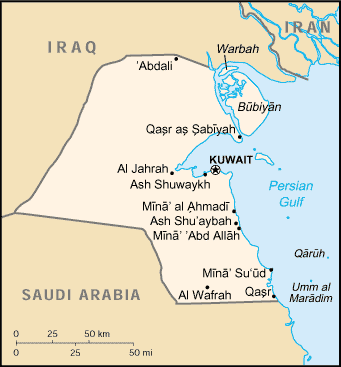
Map of Kuwait
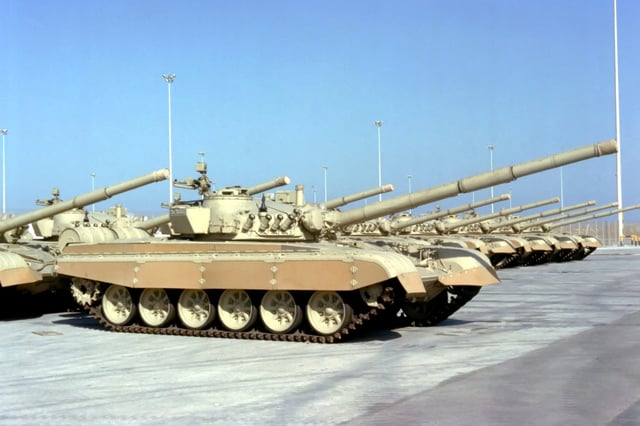
Kuwaiti Armed Forces M-84 main battle tanks
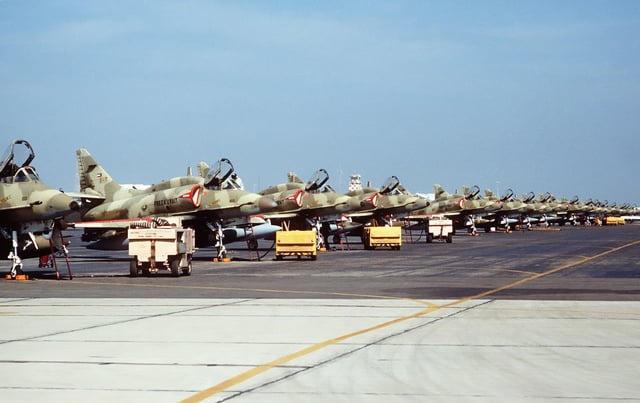
Kuwait Air Force McDonnell Douglas A-4KU Skyhawk ground-attack aircraft
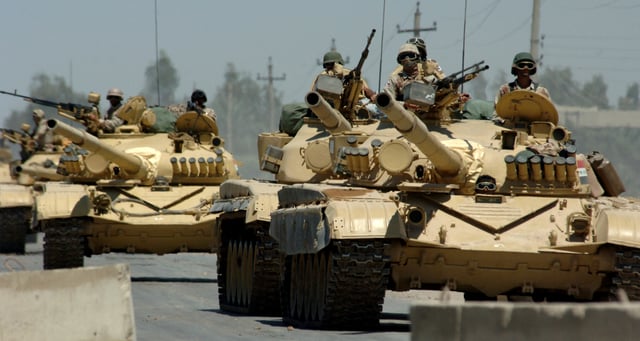
Iraqi Army T-72M main battle tanks. The T-72M tank was a common Iraqi battle tank used in the Gulf War.
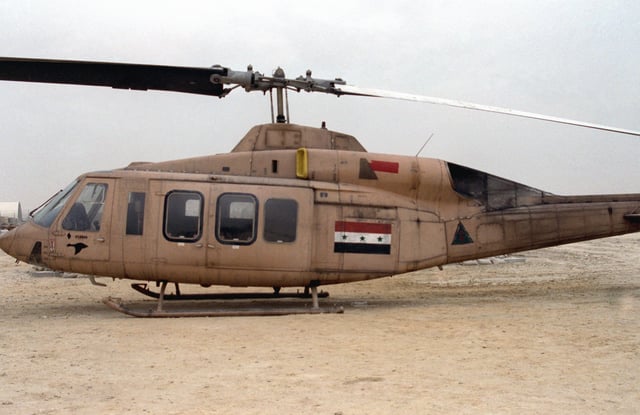
An Iraqi Air Force Bell 214ST transport helicopter, after being captured by a US Marine Corps unit at the start of the ground phase of Operation Desert Storm
At the time of the invasion, the Kuwaiti military was believed to have numbered 16,000 men, arranged into three armored, one mechanised infantry and one under-strength artillery brigade.[57] The pre-war strength of the Kuwait Air Force was around 2,200 Kuwaiti personnel, with 80 fixed-wing aircraft and 40 helicopters.[57] In spite of Iraqi saber rattling, Kuwait did not mobilize its force; the army had been stood down on 19 July,[58] and at the time of the Iraqi invasion many Kuwaiti military personnel were on leave.
By 1988, at the end of the Iran–Iraq war, the Iraqi Army was the world's fourth largest army, consisting of 955,000 standing soldiers and 650,000 paramilitary forces in the Popular Army. According to John Childs and André Corvisier, a low estimate shows the Iraqi Army capable of fielding 4,500 tanks, 484 combat aircraft and 232 combat helicopters.[59] According to Michael Knights, a high estimate shows the Iraqi Army capable of fielding one million men and 850,000 reservists, 5,500 tanks, 3,000 artillery pieces, 700 combat aircraft and helicopters; it held 53 divisions, 20 special-forces brigades, and several regional militias, and had a strong air defense.[60]
Iraqi commandos infiltrated the Kuwaiti border first to prepare for the major units, which began the attack at midnight. The Iraqi attack had two prongs, with the primary attack force driving south straight for Kuwait City down the main highway, and a supporting attack force entering Kuwait farther west, but then turning and driving east, cutting off Kuwait City from the country's southern half. The commander of a Kuwaiti armored battalion, 35th Armoured Brigade, deployed them against the Iraqi attack and was able to conduct a robust defense at the Battle of the Bridges near Al Jahra, west of Kuwait City.[61]
Kuwaiti aircraft scrambled to meet the invading force, but approximately 20% were lost or captured. A few combat sorties were flown against Iraqi ground forces.[62]
The main Iraqi thrust into Kuwait City was conducted by commandos deployed by helicopters and boats to attack the city from the sea, while other divisions seized the airports and two airbases. The Iraqis attacked the Dasman Palace, the Royal Residence of Kuwait's Emir, Jaber Al-Ahmad Al-Jaber Al-Sabah, which was defended by the Emiri Guard supported with M-84 tanks. In the process, the Iraqis killed Fahad Al-Ahmed Al-Jaber Al-Sabah, the Emir's youngest brother.
Within 12 hours, most resistance had ended within Kuwait, and the royal family had fled, leaving Iraq in control of most of Kuwait.[56] After two days of intense combat, most of the Kuwaiti military were either overrun by the Iraqi Republican Guard, or had escaped to Saudi Arabia. The Emir and key ministers were able to get out and head south along the highway for refuge in Saudi Arabia. Iraqi ground forces consolidated their control of Kuwait City, then headed south and redeployed along the Saudi border. After the decisive Iraqi victory, Saddam initially installed a puppet regime known as the "Provisional Government of Free Kuwait" before installing his cousin Ali Hassan al-Majid as Kuwait's governor on 8 August.
After the invasion, the Iraqi military looted over $1,000,000,000 in banknotes from Kuwait's Central Bank.[63] At the same time, Saddam Hussein made the Kuwaiti dinar equal to the Iraqi dinar, thereby lowering the Kuwaiti currency to one-twelfth of its original value. In response, Sheikh Jaber al-Ahmad al-Sabah ruled the banknotes as invalid and refused to reimburse stolen notes, which became worthless because of a UN embargo. After the conflict ended, many of the stolen banknotes made their way back into circulation. Today, the stolen banknotes are a collectible for numismatists.[64]
Kuwaiti resistance movement
Kuwaitis founded a local armed resistance movement following the Iraqi occupation of Kuwait.[65][66][67] The Kuwaiti resistance's casualty rate far exceeded that of the coalition military forces and Western hostages.[68] The resistance predominantly consisted of ordinary citizens who lacked any form of training and supervision.[68]
Run-up to the war
Diplomatic means
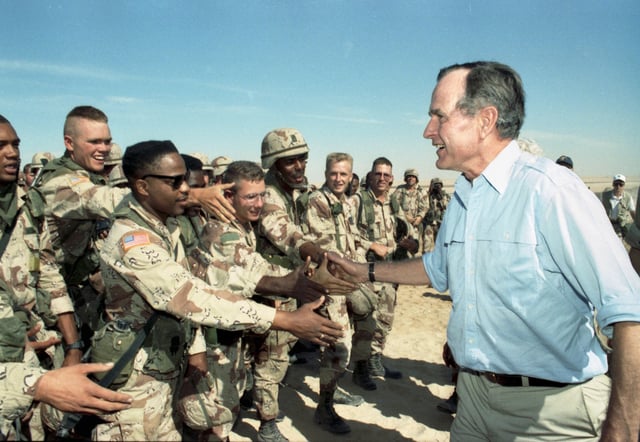
President Bush visiting American troops in Saudi Arabia on Thanksgiving Day, 1990
A key element of US political, military and energy economic planning occurred in early 1984. The Iran–Iraq war had been going on for five years by that time and there were significant casualties on both sides, reaching into the hundreds of thousands. Within President Ronald Reagan's National Security Council concern was growing that the war could spread beyond the boundaries of the two belligerents. A National Security Planning Group meeting was formed, chaired by then Vice President George Bush, to review US options. It was determined that there was a high likelihood that the conflict would spread into Saudi Arabia and other Gulf states, but that the United States had little capability to defend the region. Furthermore, it was determined that a prolonged war in the region would induce much higher oil prices and threaten the fragile recovery of the world economy, which was just beginning to gain momentum. On 22 May 1984, President Reagan was briefed on the project conclusions in the Oval Office by William Flynn Martin who had served as the head of the NSC staff that organized the study. The full declassified presentation can be seen here.[69] The conclusions were threefold: first, oil stocks needed to be increased among members of the International Energy Agency and, if necessary, released early in the event of oil market disruption; second, the United States needed to beef up the security of friendly Arab states in the region; and third, an embargo should be placed on sales of military equipment to Iran and Iraq. The plan was approved by President Reagan and later affirmed by the G-7 leaders headed by the United Kingdom's Prime Minister, Margaret Thatcher, in the London Summit of 1984. The plan was implemented and became the basis for US preparedness to respond to the Iraqi occupation of Kuwait in 1991.
Within hours of the invasion, Kuwait and US delegations requested a meeting of the UN Security Council, which passed Resolution 660, condemning the invasion and demanding a withdrawal of Iraqi troops.[70][71] On 3 August 1990, the Arab League passed its own resolution, which called for a solution to the conflict from within the league, and warned against outside intervention. Iraq and Libya were the only two Arab League states that opposed the resolution for Iraq to withdraw from Kuwait; the PLO opposed it as well.[72] The Arab states of Yemen and Jordan – a Western ally which bordered Iraq and relied on the country for economic support[73] – opposed military intervention from non-Arab states.[74] The Arab state of Sudan aligned itself with Saddam.[73]
On 6 August, Resolution 661 placed economic sanctions on Iraq.[75][76] Resolution 665[71] followed soon after, which authorized a naval blockade to enforce the sanctions. It said the "use of measures commensurate to the specific circumstances as may be necessary ... to halt all inward and outward maritime shipping in order to inspect and verify their cargoes and destinations and to ensure strict implementation of resolution 661."[77][78]
The US administration had at first been indecisive with an "undertone ... of resignation to the invasion and even adaptation to it as a fait accompli" until the UK's prime minister Margaret Thatcher played a powerful role, reminding the President that appeasement in the 1930s had led to war, that Saddam would have the whole Gulf at his mercy along with 65 percent of the world's oil supply, and famously urging President Bush "not to go wobbly".[31]
Once persuaded, US officials insisted on a total Iraqi pullout from Kuwait, without any linkage to other Middle Eastern problems, accepting the British view that any concessions would strengthen Iraqi influence in the region for years to come.[79]
On 12 August 1990, Saddam "propose[d] that all cases of occupation, and those cases that have been portrayed as occupation, in the region, be resolved simultaneously". Specifically, he called for Israel to withdraw from occupied territories in Palestine, Syria, and Lebanon, Syria to withdraw from Lebanon, and "mutual withdrawals by Iraq and Iran and arrangement for the situation in Kuwait." He also called for a replacement of US troops that mobilized in Saudi Arabia in response to Kuwait's invasion with "an Arab force", as long as that force did not involve Egypt. Additionally, he requested an "immediate freeze of all boycott and siege decisions" and a general normalization of relations with Iraq.[80] From the beginning of the crisis, President Bush was strongly opposed to any "linkage" between Iraq's occupation of Kuwait and the Palestinian issue.[81]
On 23 August, Saddam appeared on state television with Western hostages to whom he had refused exit visas. In the video, he asks a young British boy, Stuart Lockwood, whether he is getting his milk, and goes on to say, through his interpreter, "We hope your presence as guests here will not be for too long. Your presence here, and in other places, is meant to prevent the scourge of war."[82]
Another Iraqi proposal communicated in August 1990 was delivered to US National Security Advisor Brent Scowcroft by an unidentified Iraqi official. The official communicated to the White House that Iraq would "withdraw from Kuwait and allow foreigners to leave" provided that the UN lifted sanctions, allowed "guaranteed access to the Persian Gulf through the Kuwaiti islands of Bubiyan and Warbah", and allowed Iraq to "gain full control of the Rumaila oil field that extends slightly into Kuwaiti territory". The proposal also "include[d] offers to negotiate an oil agreement with the United States 'satisfactory to both nations' national security interests,' develop a joint plan 'to alleviate Iraq's economical and financial problems' and 'jointly work on the stability of the gulf.'"[83]
On 29 November 1990, the Security Council passed Resolution 678, which gave Iraq until 15 January 1991 to withdraw from Kuwait, and empowered states to use "all necessary means" to force Iraq out of Kuwait after the deadline.
In December 1990, Iraq made a proposal to withdraw from Kuwait provided that foreign troops left the region and that an agreement was reached regarding the Palestinian problem and the dismantlement of both Israel's and Iraq's weapons of mass destruction. The White House rejected the proposal.[84] The PLO's Yasser Arafat expressed that neither he nor Saddam insisted that solving the Israel–Palestine issues should be a precondition to solving the issues in Kuwait, though he did acknowledge a "strong link" between these problems.[85]
Ultimately, the US and UK stuck to their position that there would be no negotiations until Iraq withdrew from Kuwait and that they should not grant Iraq concessions, lest they give the impression that Iraq benefited from its military campaign.[79] Also, when US Secretary of State James Baker met with Tariq Aziz in Geneva, Switzerland, for last minute peace talks in early 1991, Aziz reportedly made no concrete proposals and did not outline any hypothetical Iraqi moves.[86]
On 14 January 1991, France proposed that the UN Security Council call for "a rapid and massive withdrawal" from Kuwait along with a statement to Iraq that Council members would bring their "active contribution" to a settlement of the region's other problems, "in particular, of the Arab–Israeli conflict and in particular to the Palestinian problem by convening, at an appropriate moment, an international conference" to assure "the security, stability and development of this region of the world." The French proposal was supported by Belgium (at the moment one of the rotating Council members), Germany, Spain, Italy, Algeria, Morocco, Tunisia, and several non-aligned nations. The US, the UK, and the Soviet Union rejected it; US Ambassador to the UN Thomas Pickering stated that the French proposal was unacceptable, because it went beyond previous Council resolutions on the Iraqi invasion.[87][88][89] France dropped this proposal when it found "no tangible sign of interest" from Baghdad.[90]
Military means

F-15Es parked during Operation Desert Shield

US Army soldiers from the 11th Air Defense Artillery Brigade during the Gulf War
One of the West's main concerns was the significant threat Iraq posed to Saudi Arabia. Following Kuwait's conquest, the Iraqi Army was within easy striking distance of Saudi oil fields. Control of these fields, along with Kuwaiti and Iraqi reserves, would have given Saddam control over the majority of the world's oil reserves. Iraq also had a number of grievances with Saudi Arabia. The Saudis had lent Iraq some 26 billion dollars during its war with Iran. The Saudis had backed Iraq in that war, as they feared the influence of Shia Iran's Islamic revolution on its own Shia minority. After the war, Saddam felt he should not have to repay the loans due to the help he had given the Saudis by fighting Iran.
Soon after his conquest of Kuwait, Saddam began verbally attacking the Saudis. He argued that the US-supported Saudi state was an illegitimate and unworthy guardian of the holy cities of Mecca and Medina. He combined the language of the Islamist groups that had recently fought in Afghanistan with the rhetoric Iran had long used to attack the Saudis.[91]
Acting on the Carter Doctrine policy, and out of fear the Iraqi Army could launch an invasion of Saudi Arabia, US President George H. W. Bush quickly announced that the US would launch a "wholly defensive" mission to prevent Iraq from invading Saudi Arabia, under the codename Operation Desert Shield. The operation began on 7 August 1990, when US troops were sent to Saudi Arabia, due also to the request of its monarch, King Fahd, who had earlier called for US military assistance.[55] This "wholly defensive" doctrine was quickly abandoned when, on 8 August, Iraq declared Kuwait to be Iraq's 19th province and Saddam named his cousin, Ali Hassan Al-Majid, as its military-governor.[92]
The US Navy dispatched two naval battle groups built around the aircraft carriers USS Dwight D. Eisenhower and USS Independence to the Persian Gulf, where they were ready by 8 August. The US also sent the battleships USS Missouri and USS Wisconsin to the region. A total of 48 US Air Force F-15s from the 1st Fighter Wing at Langley Air Force Base, Virginia, landed in Saudi Arabia and immediately commenced round-the-clock air patrols of the Saudi–Kuwait–Iraq border to discourage further Iraqi military advances. They were joined by 36 F-15 A-Ds from the 36th Tactical Fighter Wing at Bitburg, Germany. The Bitburg contingent was based at Al Kharj Air Base, approximately an hour south east of Riyadh. The 36th TFW would be responsible for 11 confirmed Iraqi Air Force aircraft shot down during the war. There were also two Air National Guard units stationed at Al Kharj Air Base, the South Carolina Air National Guard's 169th Fighter Wing flew bombing missions with 24 F-16s flying 2,000 combat missions and dropping four million pounds (1,800,000 kilograms; 1,800 metric tons) of munitions, and the New York Air National Guard's 174th Fighter Wing from Syracuse flew 24 F-16s on bombing missions. Military buildup continued from there, eventually reaching 543,000 troops, twice the number used in the 2003 invasion of Iraq. Much of the material was airlifted or carried to the staging areas via fast sealift ships, allowing a quick buildup.
Creating a coalition

Nations that deployed coalition forces or provided support.[93] (On behalf of Afghanistan, 300 Mujaheddin joined the coalition on Feb 11, 1991. Niger contributed 480 troops to guard shrines in Mecca and Medina on Jan 15, 1991.)[94]
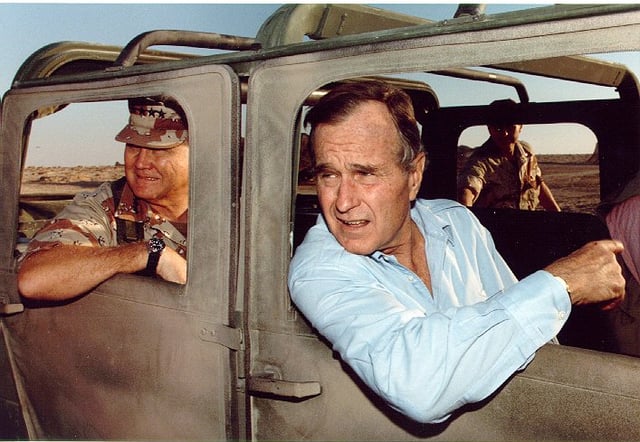
General Norman Schwarzkopf, Jr. and President George Bush visit US troops in Saudi Arabia on Thanksgiving Day, 1990.
A series of UN Security Council resolutions and Arab League resolutions were passed regarding Iraq's invasion of Kuwait. One of the most important was Resolution 678, passed on 29 November 1990, which gave Iraq a withdrawal deadline until 15 January 1991, and authorized "all necessary means to uphold and implement Resolution 660", and a diplomatic formulation authorizing the use of force if Iraq failed to comply.[95]
To ensure that economic backing, Baker went on an 11-day journey to nine countries in September 1990, which the press dubbed "The Tin Cup Trip". The first stop was Saudi Arabia, which a month before had already granted permission to the United States to use its facilities. However, Baker believed that Saudi Arabia, an immensely wealthy nation, should assume some of the cost of the military efforts, since one of the most important military objectives was to defend Saudi Arabia. When Baker asked King Fahd for 15 billion dollars, the King readily agreed, with the promise that Baker ask Kuwait for the same amount.
The next day, 7 September, he did just that, and the Emir of Kuwait, displaced in a Sheraton hotel outside his invaded country, easily agreed. Baker then moved to enter talks with Egypt, whose leadership he considered to be "the moderate voice of the Middle East". President Mubarak of Egypt was furious with Saddam for his invasion of Kuwait, and for the fact that Saddam had assured Mubarak that an invasion was not his intention. Egypt received approximately $7 billion in debt forgiveness for its providing of support and troops for the US-led intervention.[96]
After stops in Helsinki and Moscow to smooth out Iraqi demands for a Middle-Eastern peace conference with the Soviet Union, Baker traveled to Syria to discuss its role in the crisis with its President Hafez Assad. Assad had a deep personal enmity towards Saddam, which was defined by the fact that "Saddam had been trying to kill him [Assad] for years." Harboring this animosity and being impressed with Baker's diplomatic initiative to visit Damascus (relations had been severed since the 1983 bombing of US Marine barracks in Beirut), Assad agreed to pledge up to 100,000 Syrian troops to the coalition effort. This was a vital step in ensuring Arab states were represented in the coalition. In exchange, Washington gave Syrian dictator President Hafez al-Assad the green light to wipe out forces in opposition to Syria's rule in Lebanon and arranged for weapons valued at a billion dollars to be provided to Syria, mostly through Gulf states.[97] In exchange for Iran's support for the US-led intervention, the US government promised the Iranian government to end US opposition to World Bank loans to Iran. On the day before the ground invasion began, the World Bank gave Iran the first loan of $250m.[97]
Baker flew to Rome for a brief visit with the Italians in which he was promised the use of some military equipment, before journeying to Germany to meet with American ally Chancellor Kohl. Although Germany's constitution (which was brokered essentially by the United States) prohibited military involvement in outside nations, Kohl committed a two billion dollar contribution to the coalition's war effort, as well as further economic and military support of coalition ally Turkey, and the transportation of Egyptian soldiers and ships to the Persian Gulf.[98]
A coalition of forces opposing Iraq's aggression was formed, consisting of forces from 34 countries: Argentina, Australia, Bahrain, Bangladesh, Belgium, Canada, Denmark, Egypt, France, Greece, Italy, Kuwait, Morocco, Netherlands, New Zealand, Niger, Norway, Oman, Pakistan, Poland, Portugal, Qatar, South Korea, Saudi Arabia, Senegal, Sierra Leone, Singapore, Spain, Syria, the United Arab Emirates, the United Kingdom, and the US itself. It was the largest coalition since World War II.[99] US Army General Norman Schwarzkopf, Jr. was designated to be the commander of the coalition forces in the Persian Gulf area. The Soviet Union also supported United States intervention.
Although they did not contribute any forces, Japan and Germany made financial contributions totaling $10 billion and $6.6 billion respectively. US troops represented 73% of the coalition's 956,600 troops in Iraq.[100]
Many of the coalition countries were reluctant to commit military forces. Some felt that the war was an internal Arab affair or did not want to increase US influence in the Middle East. In the end, however, many nations were persuaded by Iraq's belligerence towards other Arab states, offers of economic aid or debt forgiveness, and threats to withhold aid.[101]
Justification for intervention
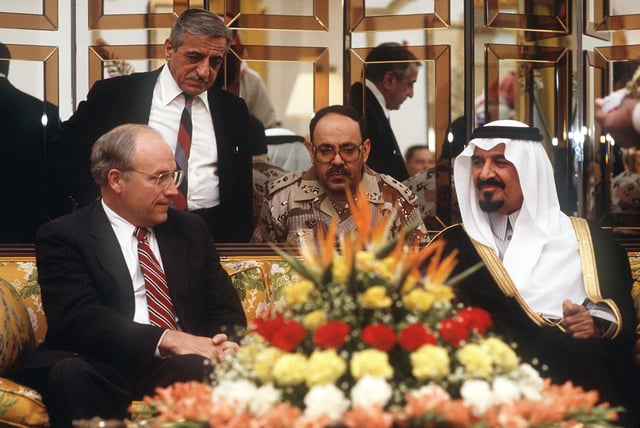
Dick Cheney meets with Prince Sultan, Minister of Defence and Aviation in Saudi Arabia to discuss how to handle the invasion of Kuwait.
The US and the UN gave several public justifications for involvement in the conflict, the most prominent being the Iraqi violation of Kuwaiti territorial integrity. In addition, the US moved to support its ally Saudi Arabia, whose importance in the region, and as a key supplier of oil, made it of considerable geopolitical importance. Shortly after the Iraqi invasion, US Defense Secretary Dick Cheney made the first of several visits to Saudi Arabia where King Fahd requested US military assistance. During a speech in a special joint session of the US Congress given on 11 September 1990, US President George Bush summed up the reasons with the following remarks: "Within three days, 120,000 Iraqi troops with 850 tanks had poured into Kuwait and moved south to threaten Saudi Arabia. It was then that I decided to act to check that aggression."[102]
The Pentagon stated that satellite photos showing a buildup of Iraqi forces along the border were this information's source, but this was later alleged to be false. A reporter for the St. Petersburg Times acquired two commercial Soviet satellite images made at the time in question, which showed nothing but empty desert.[103]
Other justifications for foreign involvement included Iraq's history of human rights abuses under Saddam. Iraq was also known to possess biological weapons and chemical weapons, which Saddam had used against Iranian troops during the Iran–Iraq War and against his own country's Kurdish population in the Al-Anfal campaign. Iraq was also known to have a nuclear weapons program, but the report about it from January 1991 was partially declassified by the CIA on 26 May 2001.[104]
Public relations campaign targeting the public
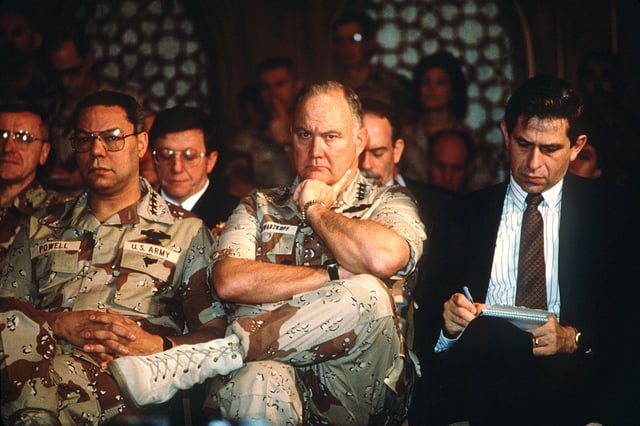
Gen. Colin Powell (left), Gen. Norman Schwarzkopf, Jr., and Paul Wolfowitz (right) listen as Secretary of Defense Dick Cheney addresses reporters regarding the 1991 Gulf War.
Although there were human rights abuses committed in Kuwait by the invading Iraqi military, the alleged incidents that received the most publicity in the US were fabrications of the public relations firm hired by the government of Kuwait to influence US opinion in favor of military intervention. Shortly after Iraq's invasion of Kuwait, the organization Citizens for a Free Kuwait was formed in the US. It hired the public relations firm Hill & Knowlton for about $11 million, paid by Kuwait's government.[105]
Among many other means of influencing US opinion, such as distributing books on Iraqi atrocities to US soldiers deployed in the region, "Free Kuwait" T-shirts and speakers to college campuses, and dozens of video news releases to television stations, the firm arranged for an appearance before a group of members of the US Congress in which a young woman identifying herself as a nurse working in the Kuwait City hospital described Iraqi soldiers pulling babies out of incubators and letting them die on the floor.[106]
The story helped tip both the public and Congress towards a war with Iraq: six Congressmen said the testimony was enough for them to support military action against Iraq and seven Senators referenced the testimony in debate. The Senate supported the military actions in a 52–47 vote. However, a year after the war, this allegation was revealed to be a fabrication. The young woman who had testified was found to be a member of Kuwait's Royal Family, in fact the daughter of Kuwait's ambassador to the US.[106] She hadn't lived in Kuwait during the Iraqi invasion.
The details of the Hill & Knowlton public relations campaign, including the incubator testimony, were published in John R. MacArthur's Second Front: Censorship and Propaganda in the Gulf War,[107] and came to wide public attention when an Op-ed by MacArthur was published in The New York Times. This prompted a reexamination by Amnesty International, which had originally promoted an account alleging even greater numbers of babies torn from incubators than the original fake testimony. After finding no evidence to support it, the organization issued a retraction. President Bush then repeated the incubator allegations on television.
At the same time, the Iraqi Army committed several well-documented crimes during its occupation of Kuwait, such as the summary execution without trial of three brothers after which their bodies were stacked in a pile and left to decay in a public street.[108] Iraqi troops also ransacked and looted private Kuwaiti homes; one residence was repeatedly defecated in.[109] A resident later commented: "The whole thing was violence for the sake of violence, destruction for the sake of destruction ... Imagine a surrealistic painting by Salvador Dalí".[110]
US President Bush repeatedly compared Saddam Hussein to Hitler.[111]
Early battles
Air campaign

The USAF F-117 Nighthawk, one of the key aircraft used in Operation Desert Storm

An Iraqi T-54A or Type 59 tank lies destroyed after a coalition bombing attack during Operation Desert Storm.
The Gulf War began with an extensive aerial bombing campaign on 16 January 1991. For 42 consecutive days and nights, the coalition forces subjected Iraq to one of the most intensive air bombardments in military history. The coalition flew over 100,000 sorties, dropping 88,500 tons of bombs,[112] and widely destroying military and civilian infrastructure.[113] The air campaign was commanded by USAF Lieutenant General Chuck Horner, who briefly served as US Central Command's Commander-in-Chief – Forward while General Schwarzkopf was still in the US.
A day after the deadline set in Resolution 678, the coalition launched a massive air campaign, which began the general offensive codenamed Operation Desert Storm. The first priority was the destruction of Iraq's Air Force and anti-aircraft facilities. The sorties were launched mostly from Saudi Arabia and the six carrier battle groups (CVBG) in the Persian Gulf and Red Sea.
The next targets were command and communication facilities. Saddam Hussein had closely micromanaged Iraqi forces in the Iran–Iraq War, and initiative at lower levels was discouraged. Coalition planners hoped that Iraqi resistance would quickly collapse if deprived of command and control.
The air campaign's third and largest phase targeted military targets throughout Iraq and Kuwait: Scud missile launchers, weapons research facilities, and naval forces. About a third of the coalition's air power was devoted to attacking Scuds, some of which were on trucks and therefore difficult to locate. US and British special operations forces had been covertly inserted into western Iraq to aid in the search for and destruction of Scuds.
Iraqi anti-aircraft defenses, including man-portable air-defense systems, were surprisingly ineffective against enemy aircraft, and the coalition suffered only 75 aircraft losses in over 100,000 sorties, 44 due to Iraqi action. Two of these losses are the result of aircraft colliding with the ground while evading Iraqi ground-fired weapons.[114][115] One of these losses is a confirmed air-air victory.[116]
Iraqi Scud missile strikes on Israel and Saudi Arabia
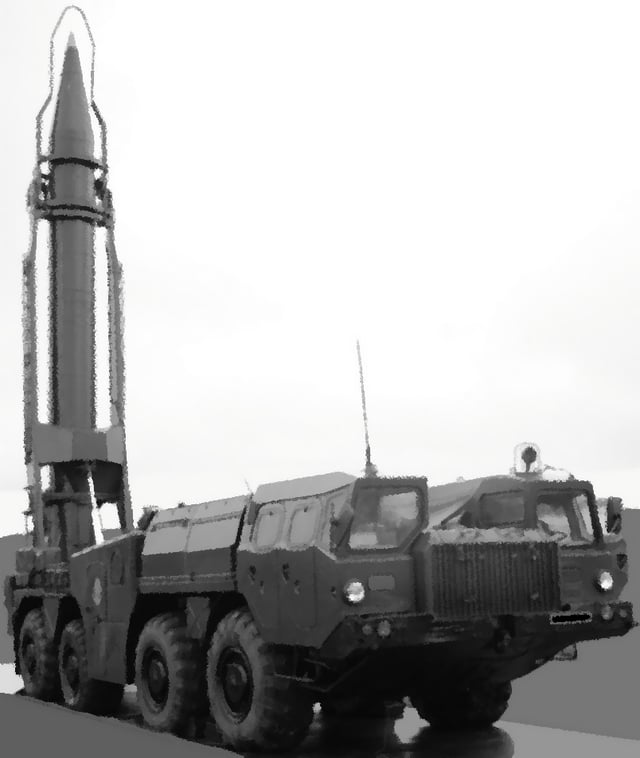
Scud Transporter Erector Launcher (TEL) with missile in upright position
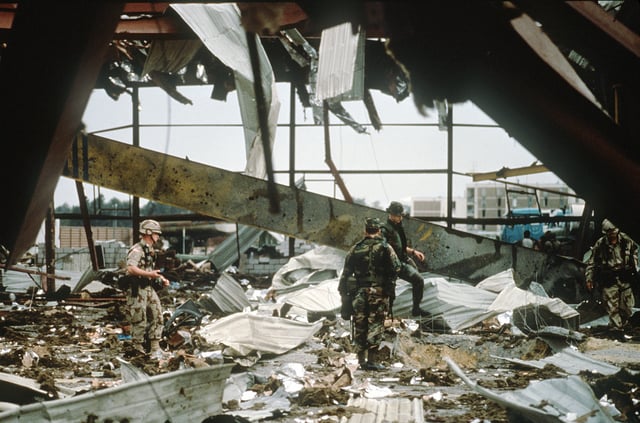
Aftermath of an Iraq Armed Forces strike on US barracks
Iraq's government made no secret that it would attack if invaded. Prior to the war's start, in the aftermath of the failed US–Iraq peace talks in Geneva, Switzerland, a reporter asked Iraq's English-speaking Foreign Minister and Deputy Prime Minister Tariq Aziz: "Mr. Foreign Minister, if war starts ... will you attack?" His response was: "Yes, absolutely, yes."[117][118]
Five hours after the first attacks, Iraq's state radio broadcast declaring that "The dawn of victory nears as this great showdown begins." Iraq fired eight missiles the next day. These missile attacks were to continue throughout the war. A total of 88 Scud missiles were fired by Iraq during the war's seven weeks.[119]
Iraq hoped to provoke a military response from Israel. The Iraqi government hoped that many Arab states would withdraw from the Coalition, as they would be reluctant to fight alongside Israel.[81] Following the first attacks, Israeli Air Force jets were deployed to patrol the northern airspace with Iraq. Israel prepared to militarily retaliate, as its policy for the previous 40 years had always been retaliation. However, President Bush pressured Israeli Prime Minister Yitzhak Shamir not to retaliate and withdraw Israeli jets, fearing that if Israel attacked Iraq, the other Arab nations would either desert the coalition or join Iraq. It was also feared that if Israel used Syrian or Jordanian airspace to attack Iraq, they would intervene in the war on Iraq's side or attack Israel. The coalition promised to deploy Patriot missiles to defend Israel if it refrained from responding to the Scud attacks.[120][121]
The Scud missiles targeting Israel were relatively ineffective, as firing at extreme range resulted in a dramatic reduction in accuracy and payload. According to the Jewish Virtual Library, a total of 74 Israelis died as a result of the Iraqi attacks: two directly and the rest from suffocation and heart attacks.[122] Approximately 230 Israelis were injured.[123] Extensive property damage was also caused, and according to Israel Ministry of Foreign Affairs, "Damage to general property consisted of 1,302 houses, 6,142 apartments, 23 public buildings, 200 shops and 50 cars."[124] It was feared that Iraq would fire missiles filled with nerve agents such as sarin. As a result, Israel's government issued gas masks to its citizens. When the first Iraqi missiles hit Israel, some people injected themselves with an antidote for nerve gas. It has been suggested that the sturdy construction techniques used in Israeli cities, coupled with the fact that Scuds were only launched at night, played an important role in limiting the number of casualties from Scud attacks.[25]
In response to the threat of Scuds on Israel, the US rapidly sent a Patriot missile air defense artillery battalion to Israel along with two batteries of MIM-104 Patriot missiles for the protection of civilians.[125] The Royal Netherlands Air Force also deployed a Patriot missile squadron to Israel and Turkey. The Dutch Defense Ministry later stated that the military use of the Patriot missile system was largely ineffective, but its psychological value for the affected populations was high.[126]
Coalition air forces were also extensively exercised in "Scud hunts" in the Iraqi desert, trying to locate the camouflaged trucks before they fired their missiles at Israel or Saudi Arabia. On the ground, special operations forces also infiltrated Iraq, tasked with locating and destroying Scuds. Once special operations were combined with air patrols, the number of attacks fell sharply, then increased slightly as Iraqi forces adjusted to coalition tactics.
As the Scud attacks continued, the Israelis grew increasingly impatient, and considered taking unilateral military action against Iraq. On 22 January 1991, a Scud missile hit the Israeli city of Ramat Gan, after two coalition Patriots failed to intercept it. Three elderly people suffered fatal heart attacks, another 96 people were injured, and 20 apartment buildings were damaged.[127][128] After this attack, the Israelis warned that if the US failed to stop the attacks, they would. At one point, Israeli commandos boarded helicopters prepared to fly into Iraq, but the mission was called off after a phone call from US Defense Secretary Dick Cheney, reporting on the extent of coalition efforts to destroy Scuds and emphasizing that Israeli intervention could endanger US forces.[129]
In addition to the attacks on Israel, 47 Scud missiles were fired into Saudi Arabia, and one missile was fired at Bahrain and another at Qatar. The missiles were fired at both military and civilian targets. One Saudi civilian was killed, and 78 others were injured. No casualties were reported in Bahrain or Qatar. The Saudi government issued all its citizens and expatriates with gas masks in the event of Iraq using missiles with chemical or biological warheads. The government broadcast alerts and 'all clear' messages over television to warn citizens during Scud attacks.
On 25 February 1991, a Scud missile hit a US Army barracks of the 14th Quartermaster Detachment, out of Greensburg, Pennsylvania, stationed in Dhahran, Saudi Arabia, killing 28 soldiers and injuring over 100.[130]
Iraqi invasion of Saudi Arabia (Battle of Khafji)

Military operations during Khafji's liberation
On 29 January, Iraqi forces attacked and occupied the lightly defended Saudi city of Khafji with tanks and infantry. The Battle of Khafji ended two days later when the Iraqis were driven back by the Saudi Arabian National Guard, supported by Qatari forces and US Marines. The allied forces used extensive artillery fire.
Both sides suffered casualties, although Iraqi forces sustained substantially more dead and captured than the allied forces. Eleven Americans were killed in two separate friendly fire incidents, an additional 14 US airmen were killed when their AC-130 gunship was shot down by an Iraqi surface-to-air missile, and two US soldiers were captured during the battle. Saudi and Qatari forces had a total of 18 dead. Iraqi forces in Khafji had 60–300 dead and 400 captured.
The Battle of Khafji was an example of how air power could single-handedly hinder the advance of enemy ground forces. Upon learning of Iraqi troop movements, 140 coalition aircraft were diverted to attack an advancing column consisting of two armored divisions in battalion-sized units. Precision stand-off attacks were conducted during the night and through to the next day. Iraqi vehicle losses included 357 tanks, 147 armored personnel carriers, and 89 mobile artillery pieces. Some crews simply abandoned their vehicles upon realizing that they could be destroyed by guided bombs without warning, stopping the divisions from massing for an organized attack on the town. One Iraqi soldier, who had fought in the Iran–Iraq War, remarked that his brigade "had sustained more punishment from allied airpower in 30 minutes at Khafji than in eight years of fighting against Iran."[131]
Counter reconnaissance

Iraqi tanks destroyed by Task Force 1-41 Infantry, February 1991
Task Force 1-41 Infantry was a US Army heavy battalion task force from the 2nd Armored Division (Forward). It was the spearhead of VII Corps, consisting primarily of the 1st Battalion, 41st Infantry Regiment, 3rd Battalion, 66th Armor Regiment, and the 4th Battalion, 3rd Field Artillery Regiment. Task Force 1–41 was the first coalition force to breach the Saudi Arabian border on 15 February 1991, and to conduct ground combat operations in Iraq engaging in direct and indirect fire fights with the enemy on 17 February 1991.[132] Shortly after arrival in theatre Task Force 1–41 Infantry received a counter-reconnaissance mission.[133] 1–41 Infantry was assisted by the 1st Squadron, 4th Armored Cavalry Regiment. This joint effort would become known as Task Force Iron.[134] Counter-reconnaissance generally includes destroying or repelling the enemy's reconnaissance elements and denying their commander any observation of friendly forces. On 15 February 1991 4th Battalion of the 3rd Field Artillery Regiment fired on a trailer and a few trucks in the Iraqi sector that were observing American forces.[135] On 16 February 1991 several groups of Iraqi vehicles appeared to be performing reconnaissance on the Task Force and were driven away by fire from 4–3 FA.[136] Another enemy platoon, including six vehicles, was reported as being to the northeast of the Task Force. They were engaged with artillery fire from 4–3 FA.[137] Later that evening another group of Iraqi vehicles was spotted moving towards the center of the Task Force. They appeared to be Iraqi Soviet-made BTRs and tanks. For the next hour the Task Force fought several small battles with Iraqi reconnaissance units. TF 1–41 IN fired TOW missiles at the Iraqi formation destroying one tank. The rest of the formation was destroyed or driven away by artillery fire from 4–3 FA.[137] On 17 February 1991 the Task Force took enemy mortar fire, but the enemy forces managed to escape.[138] Later that evening the Task Force received enemy artillery fire but suffered no casualties.[139]
Breach
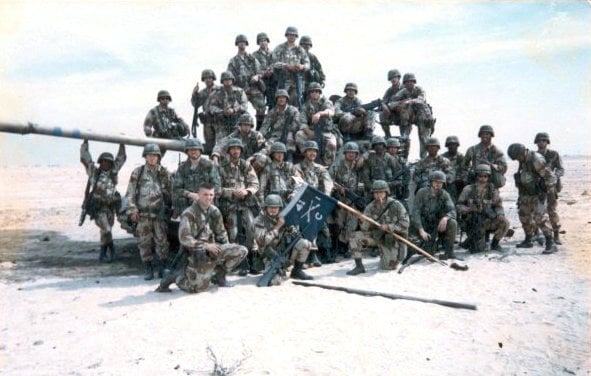
Soldiers of 2nd Platoon, Company C, 1st Battalion, 41st Infantry Regiment pose with a captured Iraqi tank, February 1991
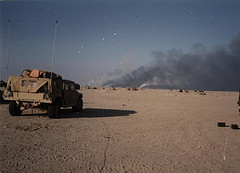
Destroyed Iraqi tanks burning at the Battle of Norfolk, February 1991

An Iraqi Republican Guard tank destroyed by Task Force 1–41 Infantry, February 1991

M270 Multiple Launch Rocket Systems attack Iraqi positions, February 1991
Task Force 1-41 Infantry was the first coalition force to breach the Saudi Arabian border on 15 February 1991 and conduct ground combat operations in Iraq engaging in direct and indirect fire fights with the enemy on 17 February 1991.[140] Prior to this action the Task Force's primary fire support battalion, 4th Battalion of the 3rd Field Artillery Regiment, participated in a massive artillery preparation. Around 300 guns from multiple nations participated in the artillery barrage. Over 14,000 rounds were fired during these missions. M270 Multiple Launch Rocket Systems contributed an additional 4,900 rockets fired at Iraqi targets.[141] Iraq lost close to 22 artillery battalions during the initial stages of this barrage,[142] including the destruction of approximately 396 Iraqi artillery pieces.[142]
By the end of these raids Iraqi artillery assets had all but ceased to exist. One Iraqi unit that was totally destroyed during the preparation was the Iraqi 48th Infantry Division Artillery Group.[143] The group's commander stated his unit lost 83 of its 100 guns to the artillery preparation.[143] This artillery prep was supplemented by air attacks by B-52 bombers and Lockheed AC-130 fixed wing gunships.[144] 1st Infantry Division Apache helicopters and B-52 bombers conducted raids against Iraq's 110th Infantry Brigade.[145] The 1st Engineer Battalion and 9th Engineer Battalion marked and proofed assault lanes under direct and indirect enemy fire to secure a foothold in enemy territory and pass the 1st Infantry Division and the British 1st Armored Division forward.[140][146]
On 24 February 1991 the 1st Cavalry Division conducted a couple artillery missions against Iraqi artillery units.[147] One artillery mission struck a series of Iraqi bunkers, reinforced by Iraqi T-55 tanks, in the sector of the Iraqi 25th Infantry Division.[147] The same day the 2nd Brigade, 1st Cavalry Division with the 1st Battalion, 5th Cavalry, 1st Battalion, 32nd Armor, and the 1st Battalion, 8th Cavalry destroyed Iraqi bunkers and combat vehicles in the sector of the Iraqi 25th Infantry Division.[147] On 24 February 2nd Brigade, 1st Infantry Division rolled through the breach in the Iraqi defense west of Wadi Al-Batin and also cleared the northeastern sector of the breach site of enemy resistance.[140] Task Force 3-37th Armor breached the Iraqi defense clearing four passage lanes and expanding the gap under direct enemy fire.[140] Also on 24 February the 1st Infantry Division along with the 1st Cavalry Division destroyed Iraqi outposts and patrols belonging to the Iraqi 26th Infantry Division.[148] The two divisions also began capturing prisoners.[148] The 1st Infantry Division cleared a zone between Phase Line Vermont and Phase Line Kansas.[148] Once the 1st Infantry Division's 3rd Battalion, 37th Armor reached the Iraqi rear defensive positions it destroyed an Iraqi D-30 artillery battery and many trucks and bunkers.[149]
Task Force 1-41 Infantry was given the task of breaching Iraq's initial defensive positions along the Iraq–Saudi Arabia border.[140] The 1st Squadron, 4th Armored Cavalry Regiment handled similar responsibilities in its sector of operations.[140] The 1st Infantry Division's 5th Battalion, 16th Infantry also played a significant role clearing the trenches and captured 160 Iraqi soldiers in the process.[149] Once into Iraqi territory Task Force 1-41 Infantry encountered multiple Iraqi defensive positions and bunkers. These defensive positions were occupied by a brigade-sized element.[150] Task Force 1-41 Infantry elements dismounted and prepared to engage the enemy soldiers who occupied these well-prepared and heavily fortified bunkers.[150] The Task Force found itself engaged in six hours of combat in order to clear the extensive bunker complex.[150] The Iraqis engaged the Task Force with small arms fire, RPGs, mortar fire, and what was left of Iraqi artillery assets. A series of battles unfolded resulting in heavy Iraqi casualties and the Iraqis being removed from their defensive positions with many becoming prisoners of war. Some escaped to be killed or captured by other coalition forces.[151] In the process of clearing the bunkers Task Force 1-41 captured two brigade command posts and the command post of the Iraqi 26th Infantry Division.[152] The Task Force also captured a brigade commander, several battalion commanders, company commanders, and staff officers.[152] As combat operations progressed Task Force 1-41 Infantry engaged at short range multiple dug in enemy tanks in ambush positions.[132] For a few hours, bypassed Iraqi RPG-equipped anti-tank teams, T-55 tanks, and dismounted Iraqi infantry fired at passing American vehicles, only to be destroyed by other US tanks and fighting vehicles following the initial forces.[153]
The 1st Infantry Division's Task Force 2-16 Infantry cleared four lanes simultaneously through an enemy fortified trench system while inflicting heavy casualties on Iraqi forces.[140] Task Force 2-16 continued the attack clearing over 13 miles of entrenched enemy positions resulting in the capture and destruction of numerous enemy vehicles, equipment, personnel and command bunkers.[140]
Ground campaign

Ground troop movements 24–28 February 1991 during Operation Desert Storm
The ground campaign consisted of three or possibly four of the largest tank battles in American military history.[154][155] The battles at 73 Easting, Norfolk, and Medina Ridge are well noted for their historic significance.[154] Some consider the battle of Medina Ridge the largest tank battle of the war.[140] The US Marine Corps also fought the biggest tank battle in its history at Kuwait International Airport.[155] The US 3rd Armored Division also fought a significant battle at Objective Dorset not far from where the battle of Norfolk was taking place. The US 3rd Armored Division destroyed approximately 300 enemy combat vehicles during this particular encounter with Iraqi forces.[140] The Iraqis suffered the loss of over 3,000 tanks and over 2,000 other combat vehicles during these battles against the American-led coalition.[21]
Kuwait's liberation

US M1A1 Abrams tanks from the 3rd Armored Division along the Line of Departure
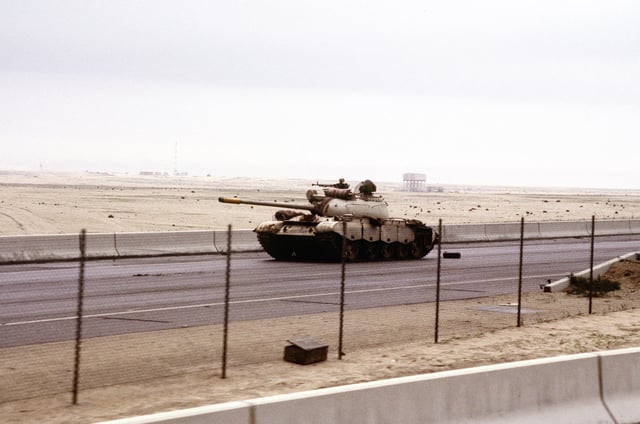
Iraqi Type 69 tank on the road into Kuwait City during the Gulf War

Two Iraqi tanks lie abandoned near Kuwait City on 26 February 1991.
US decoy attacks by air attacks and naval gunfire the night before Kuwait's liberation were designed to make the Iraqis believe the main coalition ground attack would focus on central Kuwait.
For months, American units in Saudi Arabia had been under almost constant Iraqi artillery fire, as well as threats from Scud missile or chemical attacks. On 24 February 1991, the 1st and 2nd Marine Divisions and the 1st Light Armored Infantry Battalion crossed into Kuwait and headed toward Kuwait City. They encountered trenches, barbed wire, and minefields. However, these positions were poorly defended, and were overrun in the first few hours. Several tank battles took place, but otherwise coalition troops encountered minimal resistance, as most Iraqi troops surrendered. The general pattern was that the Iraqis would put up a short fight before surrendering. However, Iraqi air defenses shot down nine US aircraft. Meanwhile, forces from Arab states advanced into Kuwait from the east, encountering little resistance and suffering few casualties.
Despite the successes of coalition forces, it was feared that the Iraqi Republican Guard would escape into Iraq before it could be destroyed. It was decided to send British armored forces into Kuwait 15 hours ahead of schedule, and to send US forces after the Republican Guard. The coalition advance was preceded by a heavy artillery and rocket barrage, after which 150,000 troops and 1,500 tanks began their advance. Iraqi forces in Kuwait counterattacked against US troops, acting on a direct order from Saddam Hussein himself. Despite the intense combat, the Americans repulsed the Iraqis and continued to advance towards Kuwait City.
Kuwaiti forces were tasked with liberating the city. Iraqi troops offered only light resistance. The Kuwaitis quickly liberated the city despite losing one soldier and having one plane shot down. On 27 February, Saddam ordered a retreat from Kuwait, and President Bush declared it liberated. However, an Iraqi unit at Kuwait International Airport appeared not to have received the message and fiercely resisted. US Marines had to fight for hours before securing the airport, after which Kuwait was declared secure. After four days of fighting, Iraqi forces were expelled from Kuwait. As part of a scorched earth policy, they set fire to nearly 700 oil wells and placed land mines around the wells to make extinguishing the fires more difficult.
Initial moves into Iraq
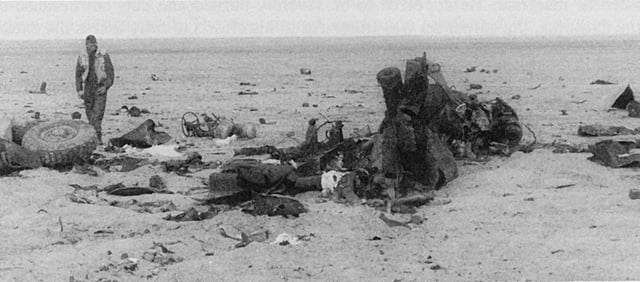
Destroyed LAV-25
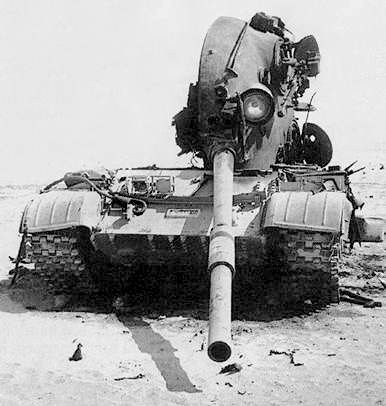
Iraqi T-62 knocked out by 3rd Armored Division fire
The war's ground phase was officially designated Operation Desert Saber.[156] The first units to move into Iraq were three patrols of the British Special Air Service's B squadron, call signs Bravo One Zero, Bravo Two Zero, and Bravo Three Zero, in late January. These eight-man patrols landed behind Iraqi lines to gather intelligence on the movements of Scud mobile missile launchers, which could not be detected from the air, as they were hidden under bridges and camouflage netting during the day.[157] Other objectives included the destruction of the launchers and their fiber-optic communications arrays that lay in pipelines and relayed coordinates to the TEL operators that were launching attacks against Israel. The operations were designed to prevent any possible Israeli intervention. Due to lack of sufficient ground cover to carry out their assignment, One Zero and Three Zero abandoned their operations, while Two Zero remained, and was later compromised, with only Sergeant Chris Ryan escaping to Syria.
Elements of the 2nd Brigade, 1st Battalion 5th Cavalry of the 1st Cavalry Division of the US Army performed a direct attack into Iraq on 15 February 1991, followed by one in force on 20 February that led directly through seven Iraqi divisions which were caught off guard. On 17 January 1991 the 101st Airborne Division Aviation Regiment fired the first shots of the war when eight AH-64 helicopters successfully destroyed two Iraqi early warning radar sites.[158] From 15–20 February, the Battle of Wadi Al-Batin took place inside Iraq; this was the first of two attacks by 1 Battalion 5th Cavalry of the 1st Cavalry Division. It was a feint attack, designed to make the Iraqis think that a coalition invasion would take place from the south. The Iraqis fiercely resisted, and the Americans eventually withdrew as planned back into the Wadi Al-Batin. Three US soldiers were killed and nine wounded, with one M2 Bradley IFV turret destroyed, but they had taken 40 prisoners and destroyed five tanks, and successfully deceived the Iraqis. This attack led the way for the XVIII Airborne Corps to sweep around behind the 1st Cav and attack Iraqi forces to the west. On 22 February 1991, Iraq agreed to a Soviet-proposed ceasefire agreement. The agreement called for Iraq to withdraw troops to pre-invasion positions within six weeks following a total ceasefire, and called for monitoring of the ceasefire and withdrawal to be overseen by the UN Security Council.
The coalition rejected the proposal, but said that retreating Iraqi forces would not be attacked, and gave 24 hours for Iraq to withdraw its forces. On 23 February, fighting resulted in the capture of 500 Iraqi soldiers. On 24 February, British and American armored forces crossed the Iraq–Kuwait border and entered Iraq in large numbers, taking hundreds of prisoners. Iraqi resistance was light, and four Americans were killed.[159]
Coalition forces enter Iraq

Iraqi 'Saddam' main battle tank destroyed during Operation Desert Storm
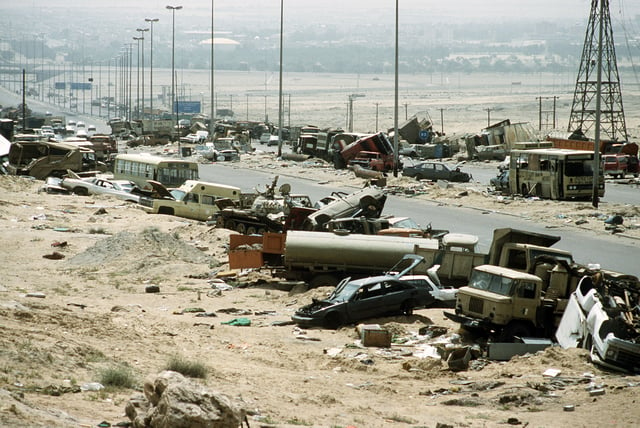
Destroyed Iraqi civilian and military vehicles on the Highway of Death

Aerial view of destroyed Iraqi T-72 tank, BMP-1 and Type 63 armored personnel carriers and trucks on Highway 8 in March 1991
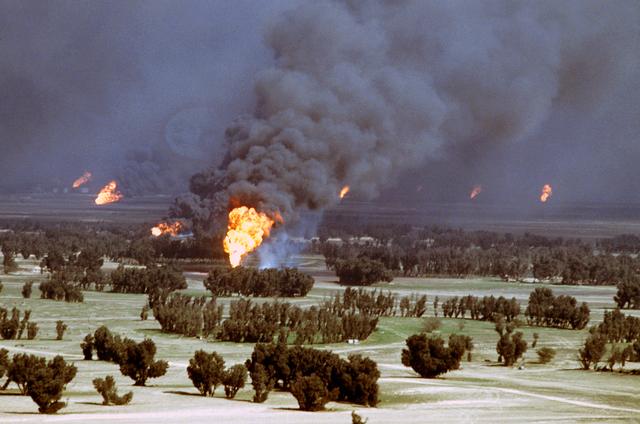
The oil fires caused were a result of the scorched earth policy of Iraqi military forces retreating from Kuwait.
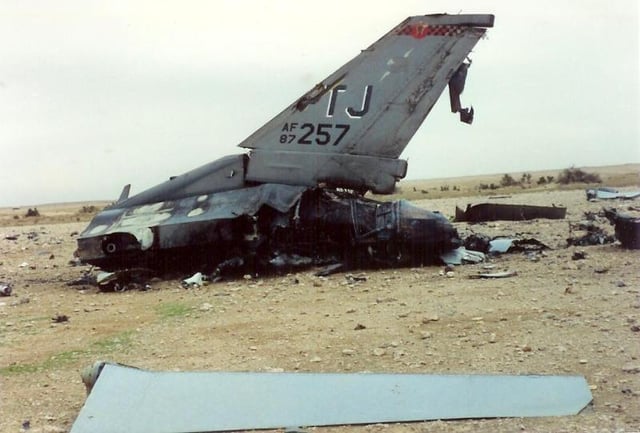
Remains of a downed F-16C
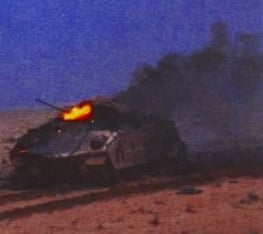
A Bradley IFV burns after being hit by Iraqi T-72 fire
Shortly afterwards, the US VII Corps, in full strength and spearheaded by the 2nd Armored Cavalry Regiment, launched an armored attack into Iraq early on 24 February, just to the west of Kuwait, taking Iraqi forces by surprise. Simultaneously, the US XVIII Airborne Corps launched a sweeping "left-hook" attack across southern Iraq's largely undefended desert, led by the US 3rd Armored Cavalry Regiment and the 24th Infantry Division (Mechanized). This movement's left flank was protected by the French Division Daguet. The 101st Airborne Division conducted a combat air assault into enemy territory.[158] The 101st Airborne Division had struck 155 miles behind enemy lines.[158] It was the deepest air assault operation in history.[158] Approximately 400 helicopters transported 2,000 soldiers into Iraq where they destroyed Iraqi columns trying to flee westward and prevented the escape of Iraqi forces.[160] The 101st Airborne Division travelled a further fifty to sixty miles into Iraq.[158] By nightfall, the 101st cut off Highway 8 which was a vital supply line running between Basra and the Iraqi forces.[158] The 101st had lost 16 soldiers in action during the 100-hour war and captured thousands of enemy prisoners of war.
The French force quickly overcame Iraq's 45th Infantry Division, suffering light casualties and taking a large number of prisoners, and took up blocking positions to prevent an Iraqi counterattack on the coalition's flank. The movement's right flank was protected by the United Kingdom's 1st Armoured Division. Once the allies had penetrated deep into Iraqi territory, they turned eastward, launching a flank attack against the elite Republican Guard before it could escape. The Iraqis resisted fiercely from dug-in positions and stationary vehicles, and even mounted armored charges.
Unlike many previous engagements, the destruction of the first Iraqi tanks did not result in a mass surrender. The Iraqis suffered massive losses and lost dozens of tanks and vehicles, while US casualties were comparatively low, with a single Bradley knocked out. Coalition forces pressed another 10 km into Iraqi territory, and captured their objective within three hours. They took 500 prisoners and inflicted heavy losses, defeating Iraq's 26th Infantry Division. A US soldier was killed by an Iraqi land mine, another five by friendly fire, and 30 wounded during the battle. Meanwhile, British forces attacked Iraq's Medina Division and a major Republican Guard logistics base. In nearly two days of some of the war's most intense fighting, the British destroyed 40 enemy tanks and captured a division commander.
Meanwhile, US forces attacked the village of Al Busayyah, meeting fierce resistance. The US force destroyed a considerable amount of military hardware and took prisoners, while suffering no casualties.
On 25 February 1991, Iraqi forces fired a Scud missile at an American barracks in Dhahran, Saudi Arabia. The missile attack killed 28 US military personnel.[161]
The coalition's advance was much swifter than US generals had expected. On 26 February, Iraqi troops began retreating from Kuwait, after they had set 737 of its oil wells on fire. A long convoy of retreating Iraqi troops formed along the main Iraq–Kuwait highway. Although they were retreating, this convoy was bombed so extensively by coalition air forces that it came to be known as the Highway of Death. Thousands of Iraqi troops were killed. American, British, and French forces continued to pursue retreating Iraqi forces over the border and back into Iraq, eventually moving to within 150 miles (240 km) of Baghdad, before withdrawing back to Iraq's border with Kuwait and Saudi Arabia.[162]
One hundred hours after the ground campaign started, on 28 February, President Bush declared a ceasefire, and he also declared that Kuwait had been liberated.
The end of active hostilities

Civilians and coalition military forces wave Kuwaiti and Saudi Arabian flags as they celebrate the retreat of Iraqi forces from Kuwait
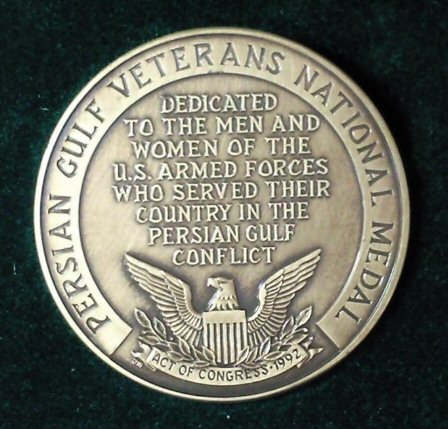
Persian Gulf Veterans National Medal of the US military
In coalition-occupied Iraqi territory, a peace conference was held where a ceasefire agreement was negotiated and signed by both sides. At the conference, Iraq was authorized to fly armed helicopters on their side of the temporary border, ostensibly for government transit due to the damage done to civilian infrastructure. Soon after, these helicopters and much of Iraq's military were used to fight an uprising in the south. The rebellions were encouraged by an airing of "The Voice of Free Iraq" on 2 February 1991, which was broadcast from a CIA-run radio station out of Saudi Arabia. The Arabic service of the Voice of America supported the uprising by stating that the rebellion was well supported, and that they soon would be liberated from Saddam.[163]
In the North, Kurdish leaders took American statements that they would support an uprising to heart, and began fighting, hoping to trigger a coup d'état. However, when no US support came, Iraqi generals remained loyal to Saddam and brutally crushed the Kurdish uprising. Millions of Kurds fled across the mountains to Turkey and Kurdish areas of Iran. These events later resulted in no-fly zones being established in northern and southern Iraq. In Kuwait, the Emir was restored, and suspected Iraqi collaborators were repressed. Eventually, over 400,000 people were expelled from the country, including a large number of Palestinians, because of PLO support of Saddam. Yasser Arafat didn't apologize for his support of Iraq, but after his death, the Fatah under Mahmoud Abbas' authority formally apologized in 2004.[164]
There was some criticism of the Bush administration, as they chose to allow Saddam to remain in power instead of pushing on to capture Baghdad and overthrowing his government. In their co-written 1998 book, A World Transformed, Bush and Brent Scowcroft argued that such a course would have fractured the alliance, and would have had many unnecessary political and human costs associated with it.
In 1992, the US Defense Secretary during the war, Dick Cheney, made the same point:
I would guess if we had gone in there, we would still have forces in Baghdad today. We'd be running the country. We would not have been able to get everybody out and bring everybody home. And the final point that I think needs to be made is this question of casualties. I don't think you could have done all of that without significant additional US casualties, and while everybody was tremendously impressed with the low cost of the (1991) conflict, for the 146 Americans who were killed in action and for their families, it wasn't a cheap war. And the question in my mind is, how many additional American casualties is Saddam [Hussein] worth? And the answer is, not that damned many. So, I think we got it right, both when we decided to expel him from Kuwait, but also when the President made the decision that we'd achieved our objectives and we were not going to go get bogged down in the problems of trying to take over and govern Iraq.[165]
On 10 March 1991, 540,000 US troops began moving out of the Persian Gulf.
On March 15, 1991, the US-led coalition restored to power Sheikh Jaber al-Ahmad al-Sabah, the unelected authoritarian ruler of Kuwait. Kuwaiti democracy advocates had been calling for restoration of Parliament that the Emir had suspended in 1986.[166]
Coalition involvement
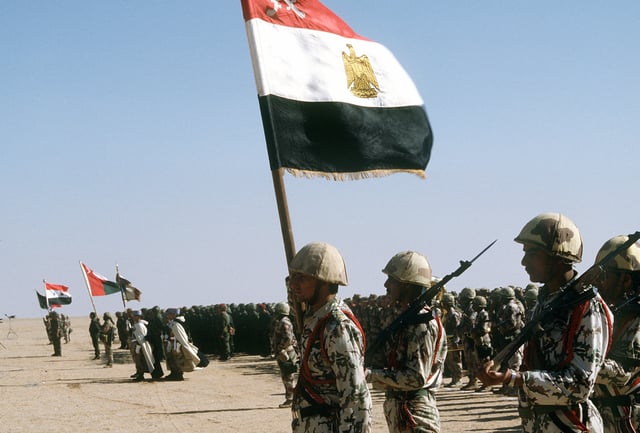
Coalition troops from Egypt, Syria, Oman, France, and Kuwait during Operation Desert Storm
Coalition members included Argentina, Australia, Bahrain, Bangladesh, Belgium, Canada, Czechoslovakia, Denmark, Egypt, France, Greece, Honduras, Hungary, Italy, Kuwait, Malaysia, Morocco, Netherlands, New Zealand, Niger, Norway, Oman, Pakistan, Philippines, Poland, Portugal, Qatar, Romania, Saudi Arabia, Senegal, South Korea, Spain, Sweden, Syria, Turkey, United Arab Emirates, United Kingdom of Great Britain and Northern Ireland, and the United States of America.[167]
Germany and Japan provided financial assistance and donated military hardware, although they did not send direct military assistance. This later became known as checkbook diplomacy.
Australia
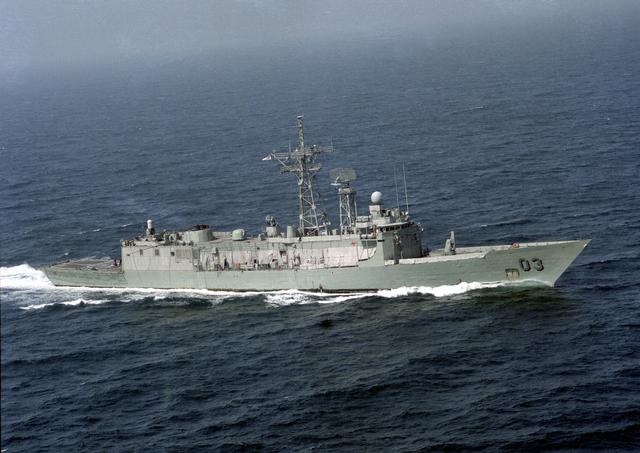
HMAS Sydney in the Persian Gulf in 1991
Australia contributed a Naval Task Group, which formed part of the multi-national fleet in the Persian Gulf and Gulf of Oman, under Operation Damask. In addition, medical teams were deployed aboard a US hospital ship, and a naval clearance diving team took part in de-mining Kuwait's port facilities following the end of combat operations. Australian forces experienced a number of incidents in the first number of weeks of the Desert Storm Campaign including the detection of significant air threats from Iraq as a part of the outer perimeter of Battle Force Zulu; the detection of free sea floating mines and assistance to the aircraft carrier USS Midway. The Australian Task Force was also placed at great risk with regard to the sea mine threat, with HMAS Brisbane narrowly avoiding a mine by a small distance. The Australians played a significant role in enforcing the sanctions put in place against Iraq following Kuwait's invasion. Following the war's end, Australia deployed a medical unit on Operation Habitat to northern Iraq as part of Operation Provide Comfort.[168]
Argentina
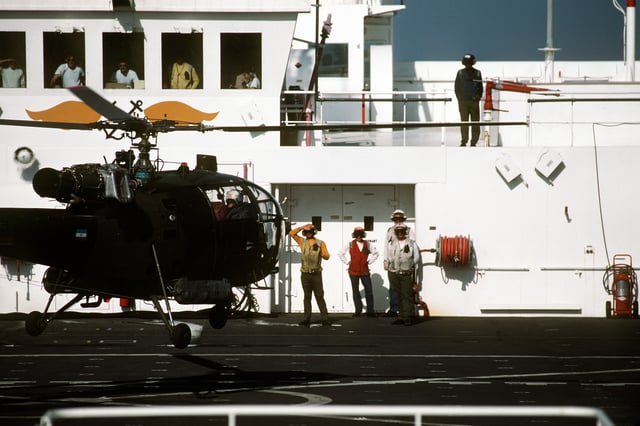
Argentine Navy Alouette III helicopter onboard USNS Comfort, February 1991
Argentina was the only Latin American country to participate in the 1991 Gulf War sending a destroyer, ARA Almirante Brown (D-10), a corvette, ARA Spiro (P-43) (later replaced by another corvette, ARA Rosales (P-42)) and a supply ship (ARA Bahía San Blas (B-4)) to participate on the United Nations blockade and sea control effort of the Persian Gulf. The success of "Operación Alfil" (English: "Operation Bishop") as it was known, with more than 700 interceptions and 25,000 miles sailed in the theatre of operations helped to overcome the so-called "Malvinas syndrome". Argentina was later classified by the US as major non-NATO ally due to her contributions during the war.
Canada
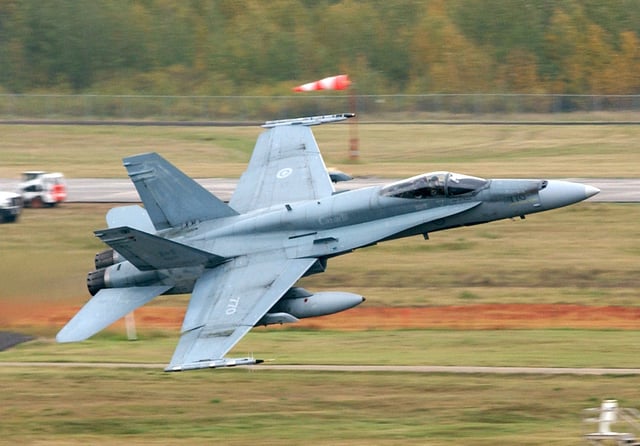
Canadian CF-18 Hornets participated in combat during the Gulf War.
Canada was one of the first countries to condemn Iraq's invasion of Kuwait, and it quickly agreed to join the US-led coalition. In August 1990, Prime Minister Brian Mulroney committed the Canadian Forces to deploy a Naval Task Group. The destroyers HMCS Terra Nova and HMCS Athabaskan joined the maritime interdiction force supported by the supply ship HMCS Protecteur in Operation Friction. The Canadian Task Group led the coalition's maritime logistics forces in the Persian Gulf. A fourth ship, HMCS Huron, arrived in-theater after hostilities had ceased and was the first allied ship to visit Kuwait.
Following the UN-authorized use of force against Iraq, the Canadian Forces deployed a CF-18 Hornet and CH-124 Sea King squadron with support personnel, as well as a field hospital to deal with casualties from the ground war. When the air war began, the CF-18s were integrated into the coalition force and were tasked with providing air cover and attacking ground targets. This was the first time since the Korean War that Canada's military had participated in offensive combat operations. The only CF-18 Hornet to record an official victory during the conflict was an aircraft involved in the beginning of the Battle of Bubiyan against the Iraqi Navy.[169]
The Canadian Commander in the Middle East was Commodore Kenneth J. Summers.
France
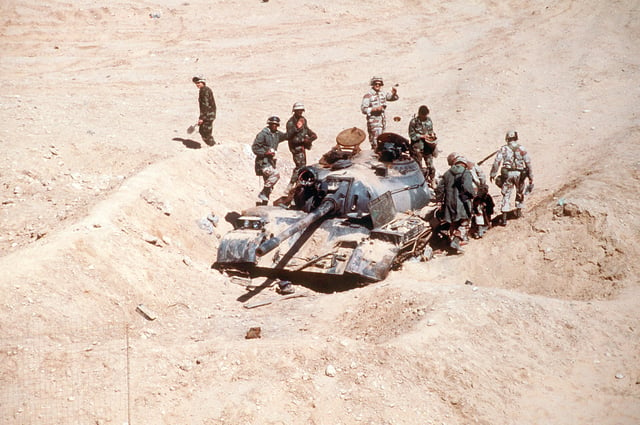
French and American soldiers inspecting an Iraqi Type 69 tank destroyed by the French Division Daguet during Operation Desert Storm
The second largest European contingent was from France, which committed 18,000 troops.[167] Operating on the left flank of the US XVIII Airborne Corps, the French Army force was the Division Daguet, including troops from the French Foreign Legion. Initially, the French operated independently under national command and control, but coordinated closely with the Americans (via CENTCOM) and Saudis. In January, the Division was placed under the tactical control of the XVIII Airborne Corps. France also deployed several combat aircraft and naval units. The French called their contribution Opération Daguet.
United Kingdom
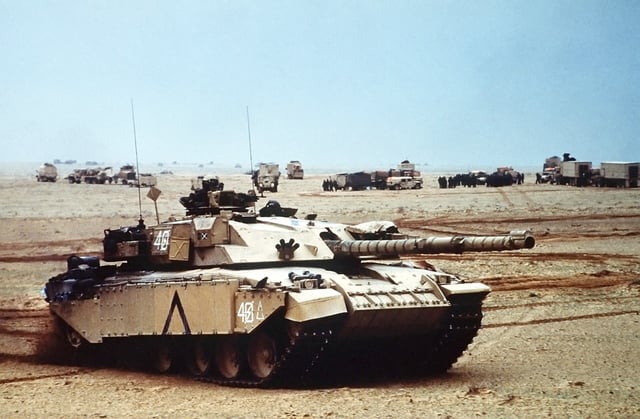
British Army Challenger 1 main battle tank during Operation Desert Storm
The United Kingdom committed the largest contingent of any European state that participated in the war's combat operations. Operation Granby was the code name for the operations in the Persian Gulf. British Army regiments (mainly with the 1st Armoured Division), Royal Air Force, Naval Air Squadrons and Royal Navy vessels were mobilized in the Persian Gulf. Both Royal Air Force and Naval Air Squadrons, using various aircraft, operated from airbases in Saudi Arabia and Naval Air Squadrons from various vessels in the Persian Gulf. The United Kingdom played a major role in the Battle of Norfolk where its forces destroyed over 200 Iraqi tanks and a large quantity of other vehicles.[170][171] After 48 hours of combat the British 1st Armoured Division destroyed or isolated four Iraqi infantry divisions (the 26th, 48th, 31st, and 25th) and overran the Iraqi 52nd Armored Division in several sharp engagements.[171]
Chief Royal Navy vessels deployed to the Persian Gulf included Broadsword-class frigates, and Sheffield-class destroyers; other R.N. and RFA ships were also deployed. The light aircraft carrier HMS Ark Royal was deployed to the Mediterranean Sea.
Special operations forces were deployed in the form of several SAS squadrons.
Casualties
Civilian
Over 1,000 Kuwaiti civilians were killed by Iraqis.[174] More than 600 Kuwaitis went missing during Iraq's occupation,[175] and approximately 375 remains were found in mass graves in Iraq. The increased importance of air attacks from both coalition warplanes and cruise missiles led to controversy over the number of civilian deaths caused during Desert Storm's initial stages. Within Desert Storm's first 24 hours, more than 1,000 sorties were flown, many against targets in Baghdad. The city was the target of heavy bombing, as it was the seat of power for Saddam and the Iraqi forces' command and control. This ultimately led to civilian casualties.
In one noted incident, two USAF stealth planes bombed a bunker in Amiriyah, causing the deaths of 408 Iraqi civilians who were in the shelter.[176] Scenes of burned and mutilated bodies were subsequently broadcast, and controversy arose over the bunker's status, with some stating that it was a civilian shelter, while others contended that it was a center of Iraqi military operations, and that the civilians had been deliberately moved there to act as human shields.
Saddam's government gave high civilian casualty figures in order to draw support from Islamic countries. The Iraqi government claimed that 2,300 civilians died during the air campaign.[177] According to the Project on Defense Alternatives study, 3,664 Iraqi civilians were killed in the conflict.[178]
A Harvard University study predicted tens of thousands of additional Iraqi civilians deaths by the end of 1991 due to the "public health catastrophe" caused by the destruction of the country's electrical generating capacity. "Without electricity, hospitals cannot function, perishable medicines spoil, water cannot be purified and raw sewage cannot be processed," the Harvard report said. The US government refused to release its own study of the effects of the Iraqi public health crisis.[179]
An investigation by Beth Osborne Daponte estimated total civilian fatalities at about 3,500 from bombing, and some 100,000 from the war's other effects.[180][181][182] Daponte later raised her estimate of the number of Iraqi deaths caused directly and indirectly by the Gulf War to between 142,500 and 206,000.[183]
Iraqi
A United Nations report in March 1991 described the effect on Iraq of the US-led bombing campaign as "near apocalyptic," bringing back Iraq to the "pre-industrial age."[184] The exact number of Iraqi combat casualties is unknown, but is believed to have been heavy. Some estimate that Iraq sustained between 20,000 and 35,000 fatalities.[180] A report commissioned by the US Air Force estimated 10,000–12,000 Iraqi combat deaths in the air campaign, and as many as 10,000 casualties in the ground war.[185] This analysis is based on Iraqi prisoner of war reports.
According to the Project on Defense Alternatives study, between 20,000 and 26,000 Iraqi military personnel were killed in the conflict while 75,000 others were wounded.[178]
According to Kanan Makiya, "For the Iraqi people, the cost of enforcing the will of the United Nations has been grotesque."[186] General Schwarzkopf talked about "a very, very large number of dead in these units, a very, very large number indeed.”[187] The chairman of the House Armed Services Committee, Les Aspin, estamited that "at least 65,000 Iraqi soldiers were killed".[187] A figure was supported by Israeli sources who speak of "one to two hundred thousand Iraqi casualties." Most of the killing "took place during the ground war. Fleeing soldiers were bombed with a neat device known as a “fuel-air explosive."[187]
Coalition
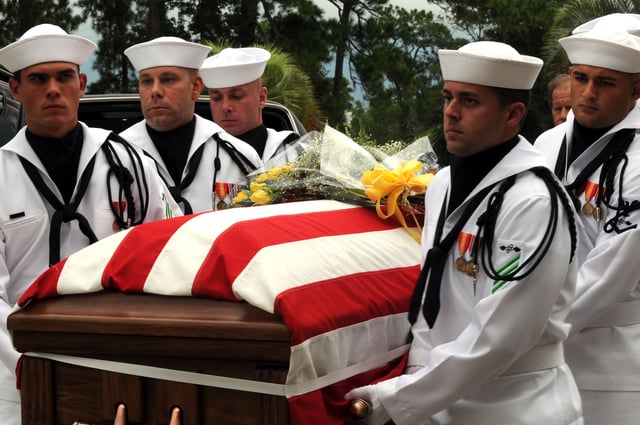
Sailors from a US Navy honor guard carry Navy pilot Scott Speicher's remains.
The US Department of Defense reports that US forces suffered 148 battle-related deaths (35 to friendly fire[196]), with one pilot listed as MIA (his remains were found and identified in August 2009). A further 145 Americans died in non-combat accidents.[188] The UK suffered 47 deaths (nine to friendly fire, all by US forces), France nine,[188] and the other countries, not including Kuwait, suffered 37 deaths (18 Saudis, one Egyptian, six UAE and three Qataris).[188] At least 605 Kuwaiti soldiers were still missing 10 years after their capture.[197]
The largest single loss of life among coalition forces happened on 25 February 1991, when an Iraqi Al Hussein missile hit a US military barrack in Dhahran, Saudi Arabia, killing 28 US Army Reservists from Pennsylvania. In all, 190 coalition troops were killed by Iraqi fire during the war, 113 of whom were American, out of a total of 358 coalition deaths. Another 44 soldiers were killed and 57 wounded by friendly fire. 145 soldiers died of exploding munitions or non-combat accidents.[198]
The largest accident among coalition forces happened on 21 March 1991, a Royal Saudi Air Force C-130H crashed in heavy smoke on approach to Ras Al-Mishab Airport, Saudi Arabia. 92 Senegalese soldiers and six Saudi crew members were killed.[192]
The number of coalition wounded in combat was 776, including 458 Americans.[199]
190 coalition troops were killed by Iraqi combatants, the rest of the 379 coalition deaths being from friendly fire or accidents. This number was much lower than expected. Among the American dead were three female soldiers.
Friendly fire
While the death toll among coalition forces engaging Iraqi combatants was very low, a substantial number of deaths were caused by accidental attacks from other Allied units. Of the 148 US troops who died in battle, 24% were killed by friendly fire, a total of 35 service personnel.[200] A further 11 died in detonations of coalition munitions. Nine British military personnel were killed in a friendly fire incident when a USAF A-10 Thunderbolt II destroyed a group of two Warrior IFVs.
Controversies
Gulf War illness
Many returning coalition soldiers reported illnesses following their action in the war, a phenomenon known as Gulf War syndrome or Gulf War illness. Common symptoms that were reported are chronic fatigue, fibromyalgia, and gastrointestinal disorder.[201] There has been widespread speculation and disagreement about the causes of the illness and the possibly related birth defects. Researchers found that infants born to male veterans of the 1991 war had higher rates of two types of heart valve defects. Some children born after the war to Gulf War veterans had a certain kidney defect that was not found in Gulf War veterans' children born before the war. Researchers have said that they did not have enough information to link birth defects with exposure to toxic substances.[202]
In 1994, the US Senate Committee on Banking, Housing, and Urban Affairs with Respect to Export Administration published a report entitled, "U.S. Chemical and Biological Warfare-Related Dual Use Exports to Iraq and their Possible Impact on the Health Consequences of the Gulf War". This publication, called the Riegle Report, summarized testimony this committee had received establishing that the US had in the 1980s supplied Saddam Hussein with chemical and biological warfare technology, that Hussein had used such chemical weapons against Iran and his own native Kurds, and possibly against US soldiers as well, plausibly contributing to the Gulf War Syndrome.
Effects of depleted uranium
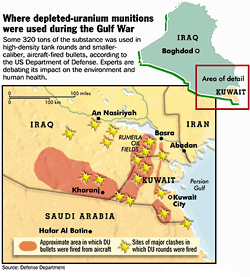
Approximate area and major clashes in which DU rounds were used
The US military used depleted uranium in tank kinetic energy penetrators and 20–30 mm cannon ordnance. Significant controversy regarding the long term safety of depleted uranium exists, including claims of pyrophoric, genotoxic, and teratogenic heavy metal effects. Many have cited its use during the war as a contributing factor to a number of major health issues in veterans and in surrounding civilian populations, including in birth defects child cancer rates. Scientific opinion on the risk is mixed.[203][204][205] In 2004, Iraq had the highest mortality rate due to leukemia of any country.[206][207][208][209]
Depleted uranium has 40% less radioactivity than natural uranium, but the negative effects should not be overlooked.[210] Some say that depleted uranium is not a significant health hazard unless it is taken into the body. External exposure to radiation from depleted uranium is generally not a major concern because the alpha particles emitted by its isotopes travel only a few centimeters in air or can be stopped by a sheet of paper. Also, the uranium-235 that remains in depleted uranium emits only a small amount of low-energy gamma radiation. However, if allowed to enter the body, depleted uranium, like natural uranium, has the potential for both chemical and radiological toxicity with the two important target organs being the kidneys and the lungs.[211]
Highway of Death
On the night of 26–27 February 1991, some Iraqi forces began leaving Kuwait on the main highway north of Al Jahra in a column of some 1,400 vehicles. A patrolling E-8 Joint STARS aircraft observed the retreating forces and relayed the information to the DDM-8 air operations center in Riyadh, Saudi Arabia.[212] These vehicles and the retreating soldiers were subsequently attacked by two A-10 aircraft, resulting in a 60 km stretch of highway strewn with debris—the Highway of Death. New York Times reporter Maureen Dowd wrote, "With the Iraqi leader facing military defeat, Mr. Bush decided that he would rather gamble on a violent and potentially unpopular ground war than risk the alternative: an imperfect settlement hammered out by the Soviets and Iraqis that world opinion might accept as tolerable."[213]
Chuck Horner, Commander of US and allied air operations, has written:
[By February 26], the Iraqis totally lost heart and started to evacuate occupied Kuwait, but airpower halted the caravan of Iraqi Army and plunderers fleeing toward Basra. This event was later called by the media "The Highway of Death." There were certainly a lot of dead vehicles, but not so many dead Iraqis. They'd already learned to scamper off into the desert when our aircraft started to attack. Nevertheless, some people back home wrongly chose to believe we were cruelly and unusually punishing our already whipped foes. ... By February 27, talk had turned toward terminating the hostilities. Kuwait was free. We were not interested in governing Iraq. So the question became "How do we stop the killing."[214]
Bulldozer assault

An armored bulldozer similar to the ones used in the attack
Another incident during the war highlighted the question of large-scale Iraqi combat deaths. This was the "bulldozer assault", wherein two brigades from the US 1st Infantry Division (Mechanized) were faced with a large and complex trench network, as part of the heavily fortified "Saddam Hussein Line". After some deliberation, they opted to use anti-mine plows mounted on tanks and combat earthmovers to simply plow over and bury alive the defending Iraqi soldiers. Not a single American was killed during the attack. Reporters were banned from witnessing the attack, near the neutral zone that touches the border between Saudi Arabia and Iraq.[215] Every American in the assault was inside an armored vehicle.[215] Patrick Day Sloyan of Newsday reported, "Bradley Fighting Vehicles and Vulcan armored carriers straddled the trench lines and fired into the Iraqi soldiers as the tanks covered them with mounds of sand. 'I came through right after the lead company,' [Col. Anthony] Moreno said. 'What you saw was a bunch of buried trenches with peoples' arms and things sticking out of them ... '"[216] However, after the war, the Iraqi government said that only 44 bodies were found.[217] In his book The Wars Against Saddam, John Simpson alleges that US forces attempted to cover up the incident.[218] After the incident, the commander of the 1st Brigade said: "I know burying people like that sounds pretty nasty, but it would be even nastier if we had to put our troops in the trenches and clean them out with bayonets."[216] Secretary of Defense Dick Cheney did not mention the First Division's tactics in an interim report to Congress on Operation Desert Storm.[215] In the report, Cheney acknowledged that 457 enemy soldiers were buried during the ground war.[215]
Palestinian exodus from Kuwait
A Palestinian exodus from Kuwait took place during and after the Gulf War. During the Gulf War, more than 200,000 Palestinians fled Kuwait during the Iraqi occupation of Kuwait due to harassment and intimidation by Iraqi security forces,[219] in addition to getting fired from work by Iraqi authority figures in Kuwait.[219] After the Gulf War, the Kuwaiti authorities forcibly pressured nearly 200,000 Palestinians to leave Kuwait in 1991.[219] Kuwait's policy, which led to this exodus, was a response to alignment of Palestinian leader Yasser Arafat and the PLO with Saddam Hussein.
The Palestinians who fled Kuwait were Jordanian citizens.[220] In 2013, there were 280,000 Jordanian citizens of Palestinian origin in Kuwait.[221] In 2012, 80,000 Palestinians (without Jordanian citizenship) lived in Kuwait.[222]
Saudi Arabia expelled Yemeni workers after Yemen supported Saddam during the Gulf War.[223]
Coalition bombing of Iraq's civilian infrastructure
In the 23 June 1991 edition of The Washington Post, reporter Bart Gellman wrote: "Many of the targets were chosen only secondarily to contribute to the military defeat of Iraq ... Military planners hoped the bombing would amplify the economic and psychological impact of international sanctions on Iraqi society ... They deliberately did great harm to Iraq's ability to support itself as an industrial society ..."[224] In the Jan/Feb 1995 edition of Foreign Affairs, French diplomat Eric Rouleau wrote: "[T]he Iraqi people, who were not consulted about the invasion, have paid the price for their government's madness ... Iraqis understood the legitimacy of a military action to drive their army from Kuwait, but they have had difficulty comprehending the Allied rationale for using air power to systematically destroy or cripple Iraqi infrastructure and industry: electric power stations (92 percent of installed capacity destroyed), refineries (80 percent of production capacity), petrochemical complexes, telecommunications centers (including 135 telephone networks), bridges (more than 100), roads, highways, railroads, hundreds of locomotives and boxcars full of goods, radio and television broadcasting stations, cement plants, and factories producing aluminum, textiles, electric cables, and medical supplies."[225] However, the UN subsequently spent billions rebuilding hospitals, schools, and water purification facilities throughout the country.[226]
Abuse of Coalition POWs
During the conflict, coalition aircrew shot down over Iraq were displayed as prisoners of war on TV, most with visible signs of abuse. Amongst several testimonies to poor treatment,[227] USAF Captain Richard Storr was allegedly tortured by Iraqis during the Persian Gulf War. Iraqi secret police broke his nose, dislocated his shoulder and punctured his eardrum.[228] Royal Air Force Tornado crew John Nichol and John Peters have both alleged that they were tortured during this time.[229][230] Nichol and Peters were forced to make statements against the war in front of television cameras. Members of British Special Air Service Bravo Two Zero were captured while providing information about an Iraqi supply line of Scud missiles to coalition forces. Only one, Chris Ryan, evaded capture while the group's other surviving members were violently tortured.[231] Flight surgeon (later General) Rhonda Cornum was raped by one of her captors[232] after the Black Hawk helicopter in which she was riding was shot down while searching for a downed F-16 pilot.
Operation Southern Watch
Since the war, the US has had a continued presence of 5,000 troops stationed in Saudi Arabia – a figure that rose to 10,000 during the 2003 conflict in Iraq.[233] Operation Southern Watch enforced the no-fly zones over southern Iraq set up after 1991; oil exports through the Persian Gulf's shipping lanes were protected by the Bahrain-based US Fifth Fleet.
Since Saudi Arabia houses Mecca and Medina, Islam's holiest sites, many Muslims were upset at the permanent military presence. The continued presence of US troops in Saudi Arabia after the war was one of the stated motivations behind the 11 September terrorist attacks,[233] the Khobar Towers bombing, and the date chosen for the 1998 US embassy bombings (7 August), which was eight years to the day that US troops were sent to Saudi Arabia.[234] Osama bin Laden interpreted the Islamic prophet Muhammad as banning the "permanent presence of infidels in Arabia".[235] In 1996, bin Laden issued a fatwa, calling for US troops to leave Saudi Arabia. In a December 1999 interview with Rahimullah Yusufzai, bin Laden said he felt that Americans were "too near to Mecca" and considered this a provocation to the entire Islamic world.[236]
Sanctions
On 6 August 1990, after Iraq's invasion of Kuwait, the UN Security Council adopted Resolution 661 which imposed economic sanctions on Iraq, providing for a full trade embargo, excluding medical supplies, food and other items of humanitarian necessity, these to be determined by the Council's sanctions committee. From 1991 until 2003, the effects of government policy and sanctions regime led to hyperinflation, widespread poverty and malnutrition.
Draining of the Qurna Marshes
The draining of the Qurna Marshes was an irrigation project in Iraq during and immediately after the war, to drain a large area of marshes in the Tigris–Euphrates river system. Formerly covering an area of around 3,000 square kilometers, the large complex of wetlands were almost completely emptied of water, and the local Shi'ite population relocated, following the war and 1991 uprisings. By 2000, United Nations Environment Programme estimated that 90% of the marshlands had disappeared, causing desertification of over 7,500 square miles (19,000 km2).
The draining of the Qurna Marshes also called The Draining of the Mesopotamian Marshes occurred in Iraq and to a smaller degree in Iran between the 1950s and 1990s to clear large areas of the marshes in the Tigris-Euphrates river system. Formerly covering an area of around 20,000 km2 (7,700 sq mi), the large complex of wetlands was 90% drained prior to the 2003 Invasion of Iraq. The marshes are typically divided into three main sub-marshes, the Hawizeh, Central, and Hammar Marshes and all three were drained at different times for different reasons. Initial draining of the Central Marshes was intended to reclaim land for agriculture but later all three marshes would become a tool of war and revenge.[240]
Many international organizations such as the UN Human Rights Commission, the Islamic Supreme Council of Iraq, the Wetlands International, and Middle East Watch have described the project as a political attempt to force the Marsh Arabs out of the area through water diversion tactics.[240]
Oil spill
On 23 January, Iraq dumped 400 million US gallons (1,500,000 m3) of crude oil into the Persian Gulf,[242] causing the largest offshore oil spill in history at that time.[241] It was reported as a deliberate natural resources attack to keep US Marines from coming ashore (Missouri and Wisconsin had shelled Failaka Island during the war to reinforce the idea that there would be an amphibious assault attempt).[243] About 30–40% of this came from allied raids on Iraqi coastal targets.[244]
Kuwaiti oil fires

Oil well fires rage outside Kuwait City in 1991
The Kuwaiti oil fires were caused by the Iraqi military setting fire to 700 oil wells as part of a scorched earth policy while retreating from Kuwait in 1991 after conquering the country but being driven out by coalition forces. The fires started in January and February 1991, and the last one was extinguished by November.[245]
The resulting fires burned out of control because of the dangers of sending in firefighting crews. Land mines had been placed in areas around the oil wells, and a military cleaning of the areas was necessary before the fires could be put out. Somewhere around 6 million barrels (950,000 m3) of oil were lost each day. Eventually, privately contracted crews extinguished the fires, at a total cost of US$1.5 billion to Kuwait.[246] By that time, however, the fires had burned for approximately 10 months, causing widespread pollution.
Cost
The cost of the war to the United States was calculated by the US Congress in April 1992 to be $61.1 billion[247] (equivalent to $100 billion in 2018).[248] About $52 billion of that amount was paid by other countries: $36 billion by Kuwait, Saudi Arabia and other Arab states of the Persian Gulf; $16 billion by Germany and Japan (which sent no combat forces due to their constitutions). About 25% of Saudi Arabia's contribution was paid in the form of in-kind services to the troops, such as food and transportation.[247] US troops represented about 74% of the combined force, and the global cost was therefore higher.
Effect on developing countries
Apart from the impact on Arab States of the Persian Gulf, the resulting economic disruptions after the crisis affected many states. The Overseas Development Institute (ODI) undertook a study in 1991 to assess the effects on developing states and the international community's response. A briefing paper finalized on the day that the conflict ended draws on their findings which had two main conclusions: Many developing states were severely affected and while there has been a considerable response to the crisis, the distribution of assistance was highly selective.[249]
The ODI factored in elements of "cost" which included oil imports, remittance flows, re-settlement costs, loss of export earnings and tourism. For Egypt, the cost totaled $1 billion, 3% of GDP. Yemen had a cost of $830 million, 10% of GDP, while it cost Jordan $1.8 billion, 32% of GDP.
International response to the crisis on developing states came with the channeling of aid through The Gulf Crisis Financial Co-ordination Group. They were 24 states, comprising most of the OECD countries plus some Gulf states: Saudi Arabia, United Arab Emirates, Qatar and Kuwait. The members of this group agreed to disperse $14 billion in development assistance.
The World Bank responded by speeding up the disbursement of existing project and adjustment loans. The International Monetary Fund adopted two lending facilities – the Enhanced Structural Adjustment Facility (ESAF) and the Compensatory & Contingency Financing Facility (CCFF). The European Community offered $2 billion in assistance.[249]
Media coverage
The war was heavily televised. For the first time, people all over the world were able to watch live pictures of missiles hitting their targets and fighters departing from aircraft carriers. Allied forces were keen to demonstrate their weapons' accuracy.
In the United States, the "big three" network anchors led the war's network news coverage: ABC's Peter Jennings, CBS's Dan Rather, and NBC's Tom Brokaw were anchoring their evening newscasts when air strikes began on 16 January 1991. ABC News correspondent Gary Shepard, reporting live from Baghdad, told Jennings of the city's quietness. But, moments later, Shepard was back on the air as flashes of light were seen on the horizon and tracer fire was heard on the ground.
On CBS, viewers were watching a report from correspondent Allen Pizzey, who was also reporting from Baghdad, when the war began. Rather, after the report was finished, announced that there were unconfirmed reports of flashes in Baghdad and heavy air traffic at bases in Saudi Arabia. On the NBC Nightly News, correspondent Mike Boettcher reported unusual air activity in Dhahran, Saudi Arabia. Moments later, Brokaw announced to his viewers that the air attack had begun.
Still, it was CNN whose coverage gained the most popularity and indeed its wartime coverage is often cited as one of the landmark events in the network's history, ultimately leading to the establishment of CNN International. CNN correspondents John Holliman and Peter Arnett and CNN anchor Bernard Shaw relayed audio reports from Baghdad's Al-Rashid Hotel as the air strikes began. The network had previously convinced the Iraqi government to allow installation of a permanent audio circuit in their makeshift bureau. When the telephones of all of the other Western TV correspondents went dead during the bombing, CNN was the only service able to provide live reporting. After the initial bombing, Arnett remained behind and was, for a time, the only American TV correspondent reporting from Iraq.
In the United Kingdom, the BBC devoted the FM portion of its national speech radio station BBC Radio 4 to an 18-hour rolling news format creating Radio 4 News FM. The station was short lived, ending shortly after President Bush declared the ceasefire and Kuwait's liberation. However, it paved the way for the later introduction of Radio Five Live.
Two BBC journalists, John Simpson and Bob Simpson (no relation), defied their editors and remained in Baghdad to report on the war's progress. They were responsible for a report which included an "infamous cruise missile that travelled down a street and turned left at a traffic light."[250]
Newspapers all over the world also covered the war and Time magazine published a special issue dated 28 January 1991, the headline "War in the Gulf" emblazoned on the cover over a picture of Baghdad taken as the war began.
US policy regarding media freedom was much more restrictive than in the Vietnam War. The policy had been spelled out in a Pentagon document entitled Annex Foxtrot. Most of the press information came from briefings organized by the military. Only selected journalists were allowed to visit the front lines or conduct interviews with soldiers. Those visits were always conducted in the presence of officers, and were subject to both prior approval by the military and censorship afterward. This was ostensibly to protect sensitive information from being revealed to Iraq. This policy was heavily influenced by the military's experience with the Vietnam War, in which public opposition within the US grew throughout the war's course. It was not only the limitation of information in the Middle East; media were also restricting what was shown about the war with more graphic depictions like Ken Jarecke's image of a burnt Iraqi soldier being pulled from the American AP wire whereas in Europe it was given extensive coverage.[251][252][253]
At the same time, the war's coverage was new in its instantaneousness. About halfway through the war, Iraq's government decided to allow live satellite transmissions from the country by Western news organizations, and US journalists returned en masse to Baghdad. NBC's Tom Aspell, ABC's Bill Blakemore, and CBS News' Betsy Aaron filed reports, subject to acknowledged Iraqi censorship. Throughout the war, footage of incoming missiles was broadcast almost immediately.
A British crew from CBS News, David Green and Andy Thompson, equipped with satellite transmission equipment, traveled with the front line forces and, having transmitted live TV pictures of the fighting en route, arrived the day before the forces in Kuwait City, broadcasting live television from the city and covering the entrance of the Arab forces the next day.
Alternative media outlets provided views in opposition to the war. Deep Dish Television compiled segments from independent producers in the US and abroad, and produced a 10-hour series that was distributed internationally, called The Gulf Crisis TV Project.[254] The series' first program War, Oil and Power[255] was compiled and released in 1990, before the war broke out. News World Order[256] was the title of another program in the series; it focused on the media's complicity in promoting the war, as well as Americans' reactions to the media coverage. In San Francisco, Paper Tiger Television West produced a weekly cable television show with highlights of mass demonstrations, artists' actions, lectures, and protests against mainstream media coverage at newspaper offices and television stations. Local media outlets in cities across the USA screened similar oppositional media.
The organization Fairness and Accuracy in Reporting (FAIR) critically analyzed media coverage during the war in various articles and books, such as the 1991 Gulf War Coverage: The Worst Censorship was at Home.[257]
Terminology
The following names have been used to describe the conflict itself: Gulf War and Persian Gulf War are the most common terms for the conflict used within western countries, though it may also be called the First Gulf War (to distinguish it from the 2003 invasion of Iraq and the subsequent Iraq War). Some authors have called it the Second Gulf War to distinguish it from the Iran–Iraq War.[258] Liberation of Kuwait (Arabic: تحرير الكويت) (taḥrīr al-kuwayt) is the term used by Kuwait and most of the coalition's Arab states, including Saudi Arabia, Bahrain, Egypt, and the United Arab Emirates. Terms in other languages include French: la Guerre du Golfe and German: Golfkrieg (Gulf War); German: Zweiter Golfkrieg (Second Gulf War); French: Guerre du Koweït (War of Kuwait).
Operational names
Most of the coalition states used various names for their operations and the war's operational phases. These are sometimes incorrectly used as the conflict's overall name, especially the US Desert Storm:
Operation Desert Shield was the US operational name for the US buildup of forces and Saudi Arabia's defense from 2 August 1990, to 16 January 1991.
Operation Desert Storm was the US name of the airland conflict from 17 January 1991, through 28 February 1991. Operation Desert Sabre (early name Operation Desert Sword) was the US name for the airland offensive against the Iraqi Army in the Kuwaiti Theater of Operations (the "100-hour war") from 24–28 February 1991, in itself, part of Operation Desert Storm.
Operation Desert Farewell was the name given to the return of US units and equipment to the US in 1991 after Kuwait's liberation, sometimes referred to as Operation Desert Calm.
Operation Granby was the British name for British military activities during the operations and conflict.
Opération Daguet was the French name for French military activities in the conflict.
Operation Friction was the name of the Canadian operations
Operazione Locusta (Italian for Locust) was the Italian name for the operations and conflict.
Campaign names
The US divided the conflict into three major campaigns:
Defense of Saudi Arabian country for the period 2 August 1990, through 16 January 1991.
Liberation and Defense of Kuwait for the period 17 January 1991, through 11 April 1991.
Southwest Asia Cease-Fire for the period 12 April 1991, through 30 November 1995, including Operation Provide Comfort.
Technology
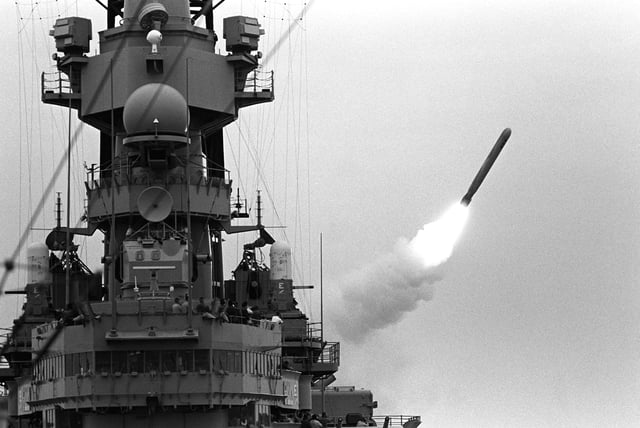
USS Missouri launching a Tomahawk missile. The Gulf War was the last conflict in which battleships were deployed in a combat role (as of 2017).
Precision-guided munitions were heralded as key in allowing military strikes to be made with a minimum of civilian casualties compared to previous wars, although they were not used as often as more traditional, less accurate bombs. Specific buildings in downtown Baghdad could be bombed while journalists in their hotels watched cruise missiles fly by.
Precision-guided munitions amounted to approximately 7.4% of all bombs dropped by the coalition. Other bombs included cluster bombs, which disperse numerous submunitions,[259] and daisy cutters, 15,000-pound bombs which can disintegrate everything within hundreds of yards.
Global Positioning System (GPS) units were relatively new at the time and were important in enabling coalition units to easily navigate across the desert. Since military GPS receivers were not available for most troops, many used commercially available units. To permit these to be used to best effect, the "selective availability" feature of the GPS system was turned off for the duration of Desert Storm, allowing these commercial receivers to provide the same precision as the military equipment.[260]
Airborne Warning and Control System (AWACS) and satellite communication systems were also important. Two examples of this are the US Navy's Grumman E-2 Hawkeye and the US Air Force's Boeing E-3 Sentry. Both were used in command and control area of operations. These systems provided essential communications links between air, ground, and naval forces. It is one of several reasons coalition forces dominated the air war.
American-made color photocopiers were used to produce some of Iraq's battle plans. Some of the copiers contained concealed high-tech transmitters that revealed their positions to American electronic warfare aircraft, leading to more precise bombings.[261]
Scud and Patriot missiles

Military personnel examine the remains of a Scud.
The role of Iraq's Scud missiles featured prominently in the war. Scud is a tactical ballistic missile that the Soviet Union developed and deployed among the forward deployed Soviet Army divisions in East Germany.
Scud missiles utilize inertial guidance which operates for the duration that the engines operate. Iraq used Scud missiles, launching them into both Saudi Arabia and Israel. Some missiles caused extensive casualties, while others caused little damage.
The US Patriot missile was used in combat for the first time. The US military claimed a high effectiveness against Scuds at the time, but later analysis gives figures as low as 9%, with 45% of the 158 Patriot launches being against debris or false targets.[262] The Dutch Ministry of Defense, which also sent Patriot missiles to protect civilians in Israel and Turkey, later disputed the higher claim.[126] Further, there is at least one incident of a software error causing a Patriot missile's failure to engage an incoming Scud, resulting in deaths.[263] Both the US Army and the missile manufacturers maintained the Patriot delivered a "miracle performance" in the Gulf War.[262]
Popular culture
The Gulf War has been the subject of several video games including Conflict: Desert Storm, Conflict: Desert Storm II and Gulf War: Operation Desert Hammer. There have also been numerous depictions in film including Jarhead (2005), which is based on US Marine Anthony Swofford's 2003 memoir of the same name.[264]
See also
1973 Samita border skirmish
United Nations Iraq–Kuwait Observation Mission (April 1991 – October 2003)
Iraq–Russia relations
Organization of United States Air Force Units in the Gulf War
SIPRI Arms Transfers Database, Iraq 1973–1990
Loss of Strength Gradient
Military history of the United States
Post–World War II air-to-air combat losses
